- Travel Tips
- Attractions
Things to do
- Food & Wine
- Art & Culture

Rest of the world
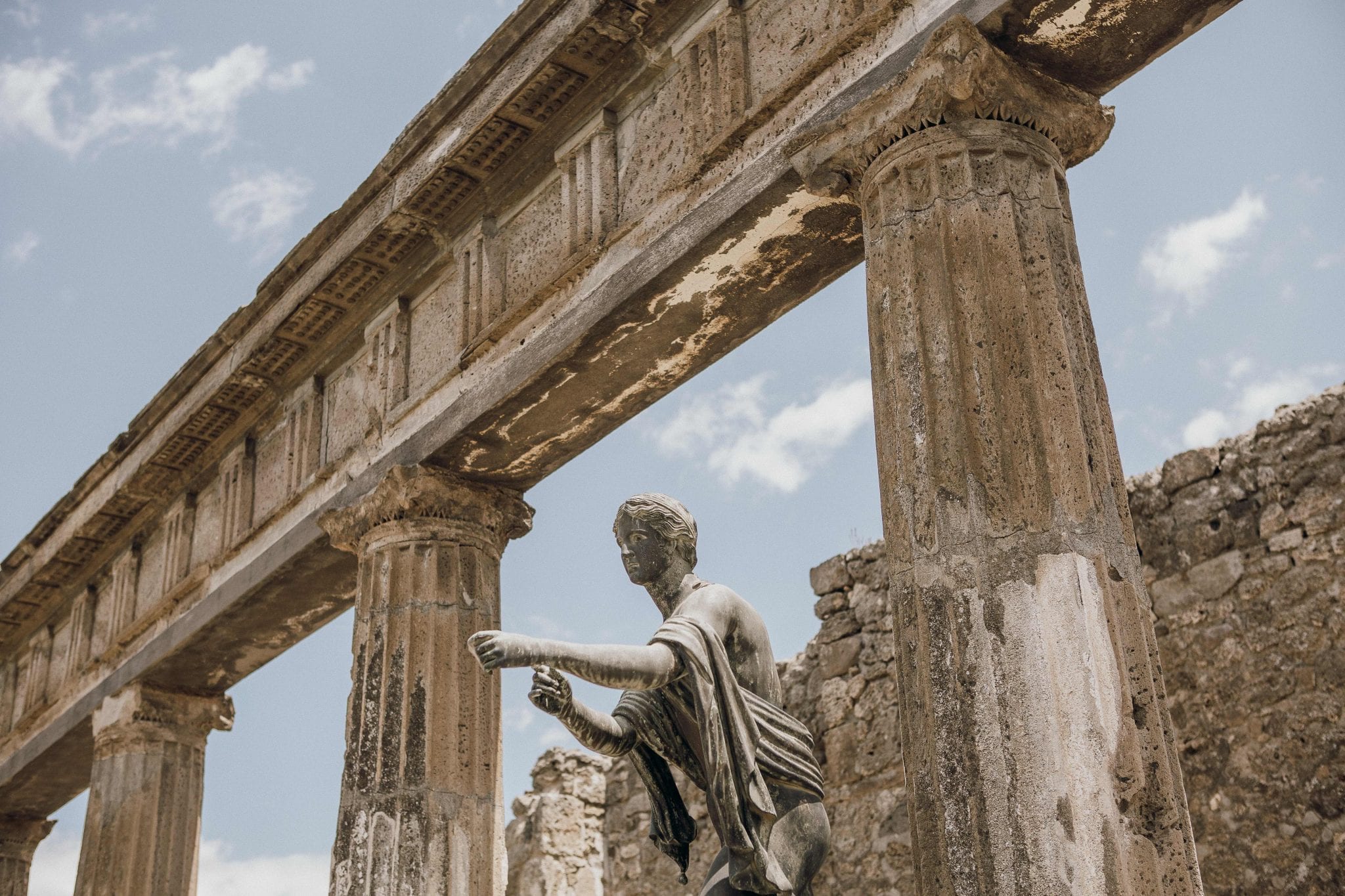

Ultimate Guide to Visiting Pompeii: What to See, Do, & Experience
- Planning your trip
July 11, 2023
Once a bustling, blue collar port town, Pompeii’s fate was sealed with the eruption of Mount Vesuvius in 7.9 A.D. Today, Pompeii is a UNESCO World Heritage site, one of the most visited sites in Italy and one of the most visited archaeological sites in all the world. Visiting Pompeii? Keep reading to see what life in ancient Rome was like – and plan ahead with our easy guide to get the most out of your visit to Pompeii.

Visiting Pompeii? Don’t miss these keys sites!
Table of Contents
How to get to Pompeii
Pompeii is a major stop and easy to reach from the major surrounding cities by train, car or even bus. Travel time by road (without traffic – which is rare on these roads) is around 2.5 hours from Rome to Pompeii, 30 mins from Naples to Pompeii, 45 minutes from Sorrento to Pompeii and 4.5 hours from Florence to Pompeii (which pretty much rules it out as a day trip from Florence).
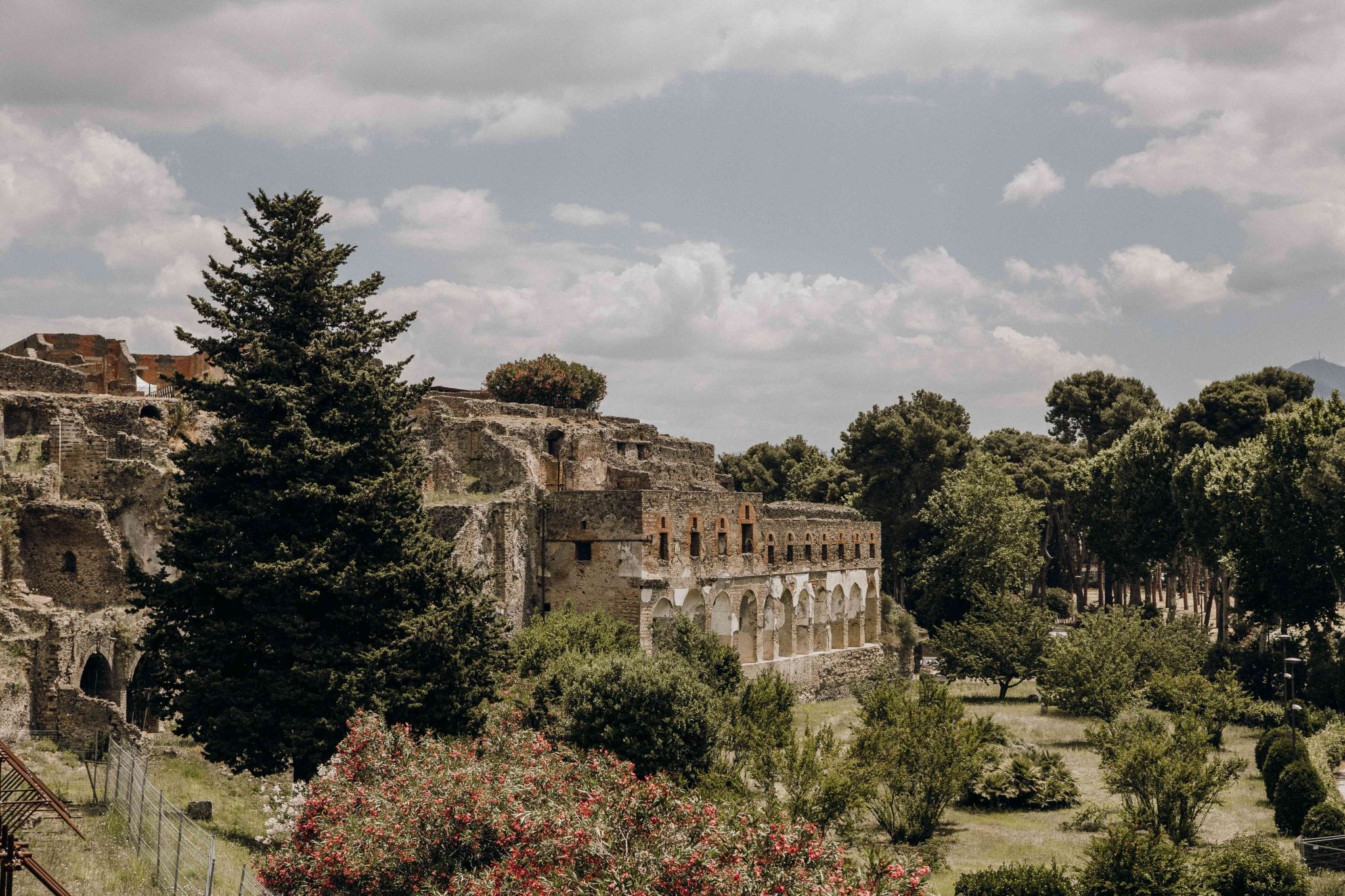
Whether you’re based in Naples or Rome, the ancient Roman town of Pompeii is certainly worth visiting.
Pompeii from Rome
If you’re planning on visiting Pompeii from Rome , perhaps the easiest option, is to book our Pompeii & Amalfi Day Trip from Rome , which includes a guided tour of Pompeii, a scenic drive along the Amalfi Coast and a stop in Positano. Independent travelers can book a transfer service, which is certainly the fastest option, although not the cheapest. The budget conscious will want to travel by train, which is largely easy to navigate and less expensive, although more time-consuming.
From Rome, take the train to Naples at the Napoli Centrale Station. The high-speed train, either Frecciarossa or Italo, takes about an hour and ten minutes each way. You can view train times and prices as well as book your tickets in advance on www.trenitalia.com . From Napoli Centrale, take the Circumvesuviana train, the old but reliable commuter train of Campania, on the Napoli-Sorrento Circumvesuviana line. The Circumvesuviana runs trains about every half hour and it takes about 30 minutes to arrive at your Pompeii stop, Pompeii Scavi – Villa dei Misteri.
Pompeii from Naples (or Sorrento)
From Sorrento or Naples, you’ll simply take the Napoli-Sorrento Circumvesuviana line to the Pompeii Scavi – Villa dei Misteri stop. Once again, it’s about a 30 minute train ride from each city. The Circumvesuviana trains are often very crowded and you might find standing room only.
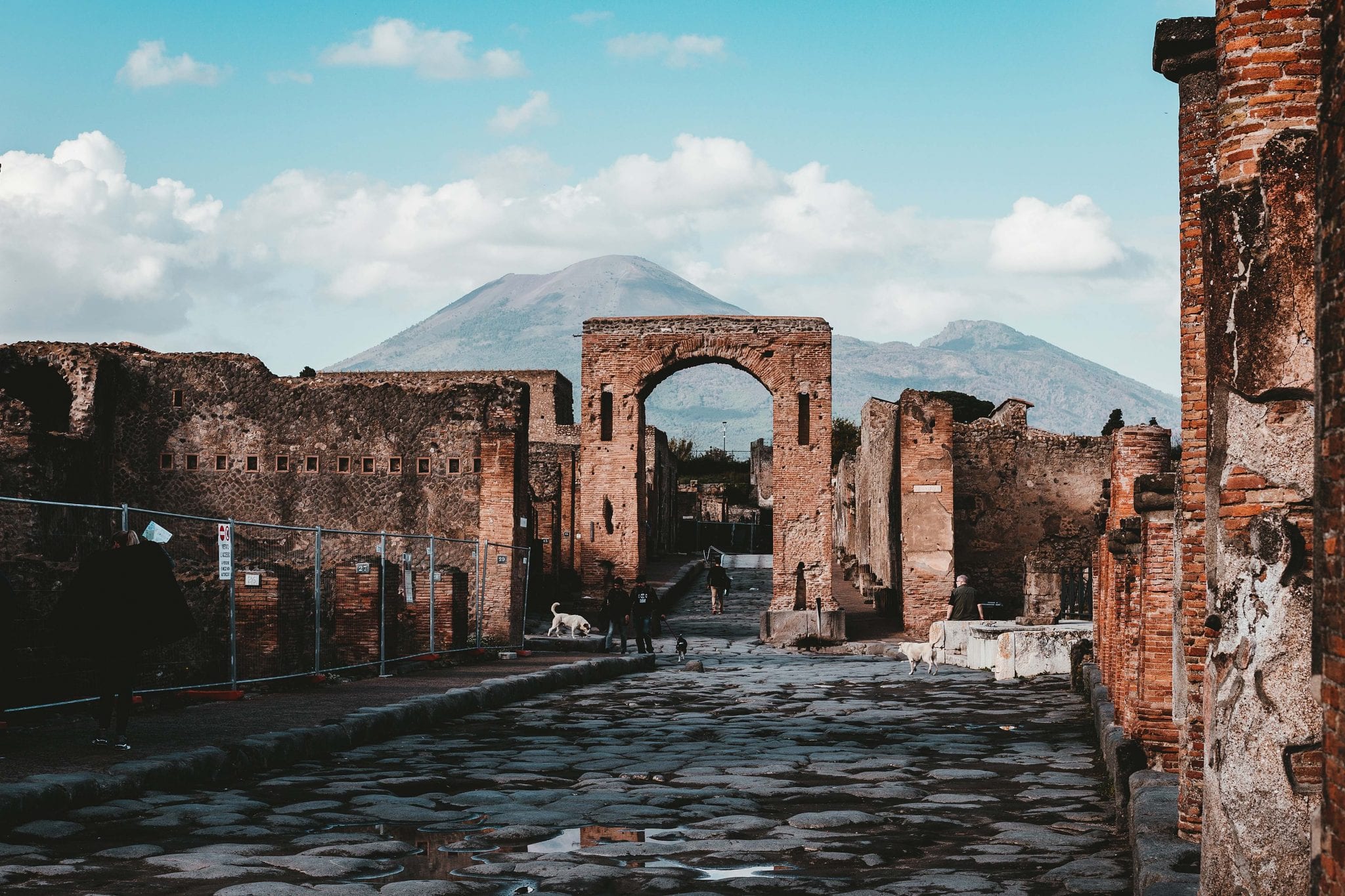
No matter when you plan on visiting Pompeii, it’s a good idea to bring an updated map.
Pompeii from the Amalfi Coast
If you’d like to get a better view of the Almafi Coast (albeit a rocky, potentially crowded, view) take the SITA bus from Piazza Esedra in Naples or from the Sorrento train station. One or two busses run per hour and stop at all the major towns along the coast, including Pompei (the modern day town, as opposed to Pompeii the archaeological site). A ticket costs 2.80 euro and the trip takes about 40 minutes. Check out the SITA website for more information and bus time tables (in Italian).
Read More: An Art Lover’s Guide to Pompeii – A City Frozen in Time
Know before you go
Signage and eating in pompeii.
Unfortunately, the same attention is not lavished on visitor facilities. The site has only one restaurant-cum-cafeteria of dubious quality, and the maps – if you can get one from the information booth – are not up to date. You may even have to backtrack where streets have been blocked off.
Remember, Pompeii was once an entire maritime city, and the current site is vast! Forty-four hectares that have been excavated, but not all are accessible. Unfortunately, the beautiful site isn’t managed so well. There are often areas cordoned off with little explanation and rather poor signage. Your itinerary will be well-planned if you visit Pompeii with a tour guide, so you won’t need to worry as much. If not, plan ahead and come prepared to ensure you have a successful trip.
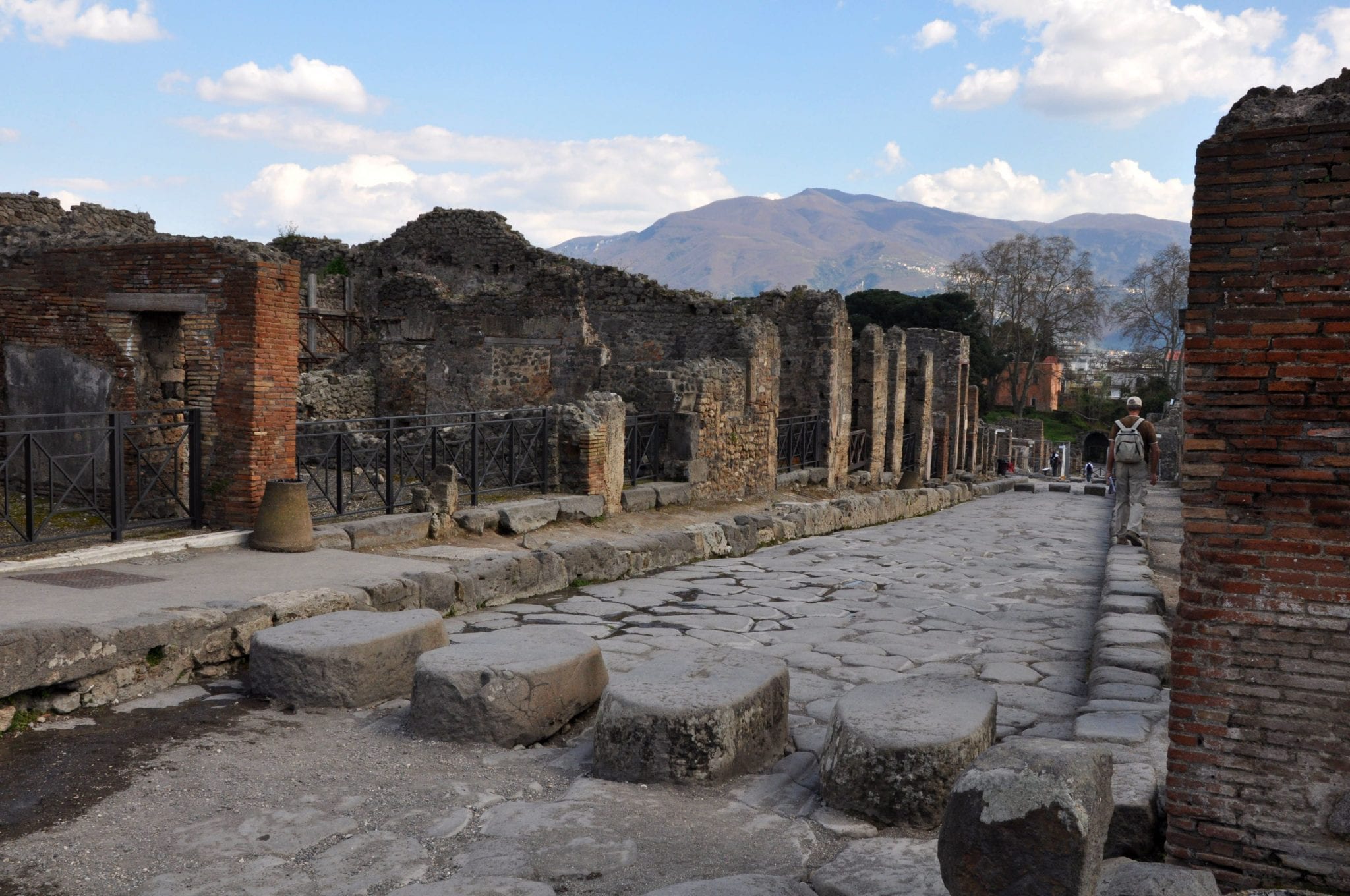
It’s also a good idea to bring good shoes when visiting Pompeii – you’ll be walking quite a lot!
What to bring on a trip to Pompeii
An up-to-date map.
You can go back in time by walking through the preserved streets of the city – by far the best way to view Pompeii. Though you could spend an entire day touring the site, the average time needed once inside is about two to three hours. Like most Roman-built cities, Pompeii is well organized with a clear street plan, but the modern-day signposts are often wrong. Though technically the information booth should have maps, you’ll have to specifically ask for one and hope that it’s been updated.
It’s better to come prepared with a current map. Touring Pompeii is not difficult, but in order not to waste time or bake unnecessarily under the Neapolitan sun, those traveling solo might want to consider bringing a guidebook as well.
A 1912 Map of Pompeii shows the sites enormous proportions. Photo by Dennis Jarvis
Sun protection, snacks, and water
Bring hats and sunscreen no matter what season and you may even want umbrellas in the summer. There is very little shelter from the sun and two to three hours outside will leave you feeling more like the ashen city than your healthy self. You’ll also want snacks and plenty of water for all that walking. Inside there is only one small convenience stand with slim offerings and unreliable hours of operation, but there are water fountains throughout the site that you can use to refill your water bottles.
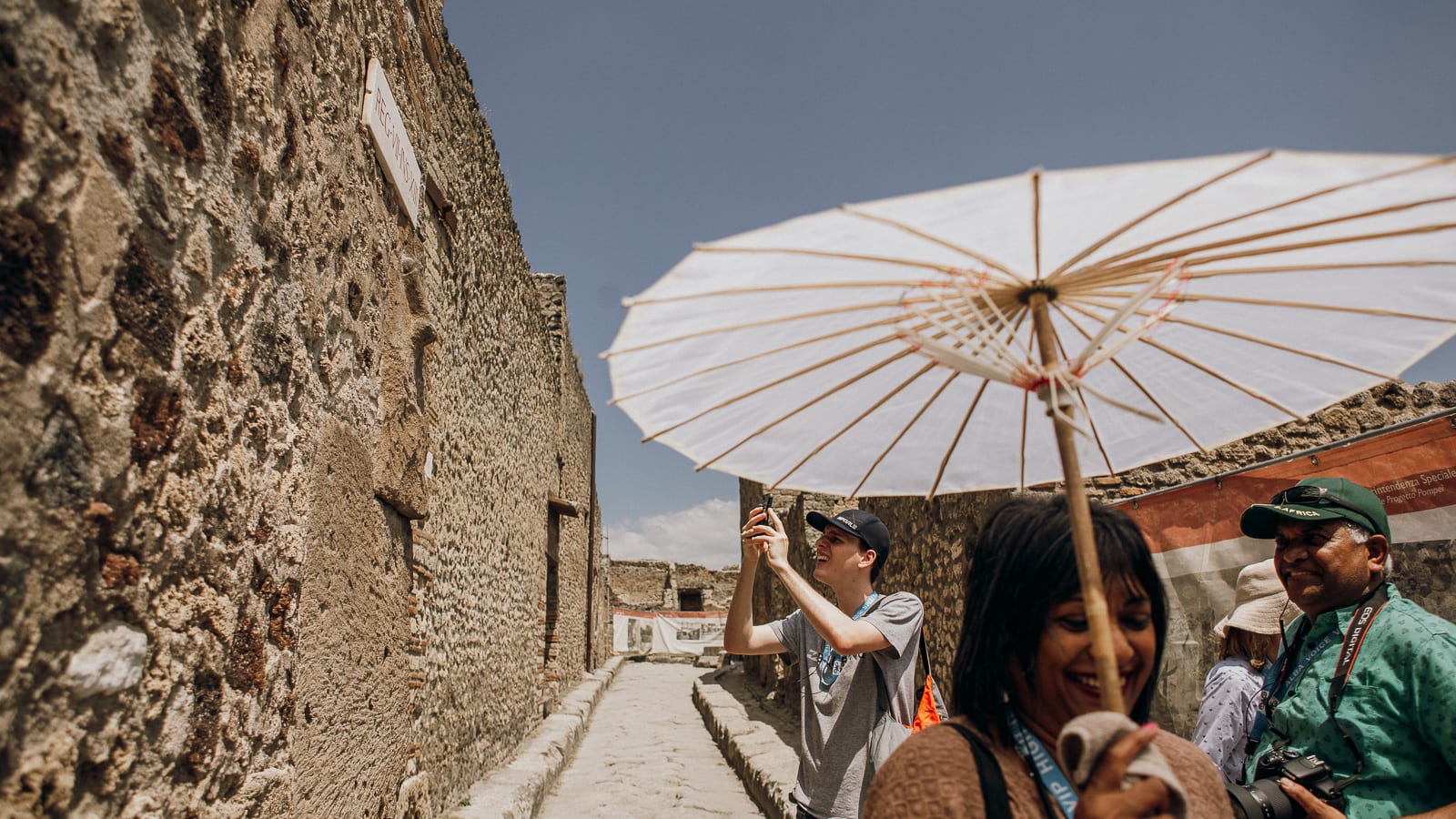
There’s very little shad in Pompeii, so bring an umbrella or other sun protection.
Pompeii Tickets
The fee to enter Pompeii is currently 19 Euros, and be sure you have cash. The ticket office doesn’t accept credit cards. You can get more information, view prices or book ahead on the official Pompeii website.
What to see at Pompeii
Before Vesuvius’ eruption in 79 AD , Pompeii was an important port town for the ancient Roman empire, which controlled the entire Mediterranean Sea. Middle class, Pompeii was a classic port town filled with sailor’s hotels, bars, public baths, taverns and brothels. The archeological site and ongoing excavations give visitors to the formerly bustling Pompeii the best look there is on ancient Roman life.
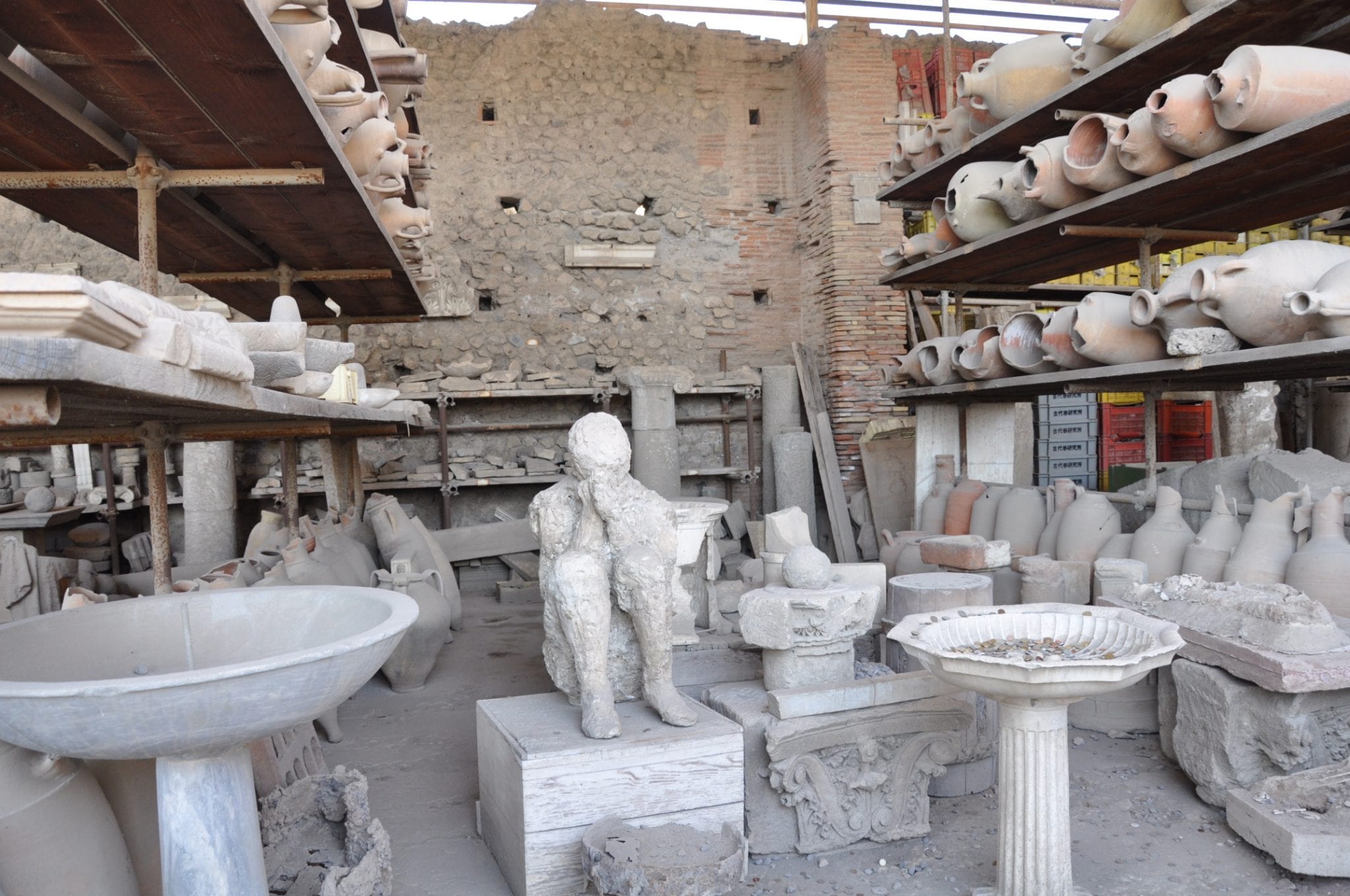
Of course, there are lots of artifacts to be seen at the Pompeii site as well.
Roman Forum (Foro) and A mphitheatre (Anfiteatro)
Go to see the Roman Forum; the theatre, whose acoustics are so good you don’t need microphones to be heard from the stage; the public baths with looming columns. Built in 70 A.D., the Anfiteatro is the oldest-known Roman amphitheatre in existence. Now covered in grass, it originally held up to 20,000 spectators.
The Forum, or Foro in Italian, and served as ancient Pompeii’s main piazza and leads to many other notable sights, such as the Basilica built in the second century BC, the Temple of Jupiter ( Tempio di Giove) which only has one triumphal arch remaining, the city’s Forum Granary and a the nearby Anfiteatro , the city’s primary meat and fish market.
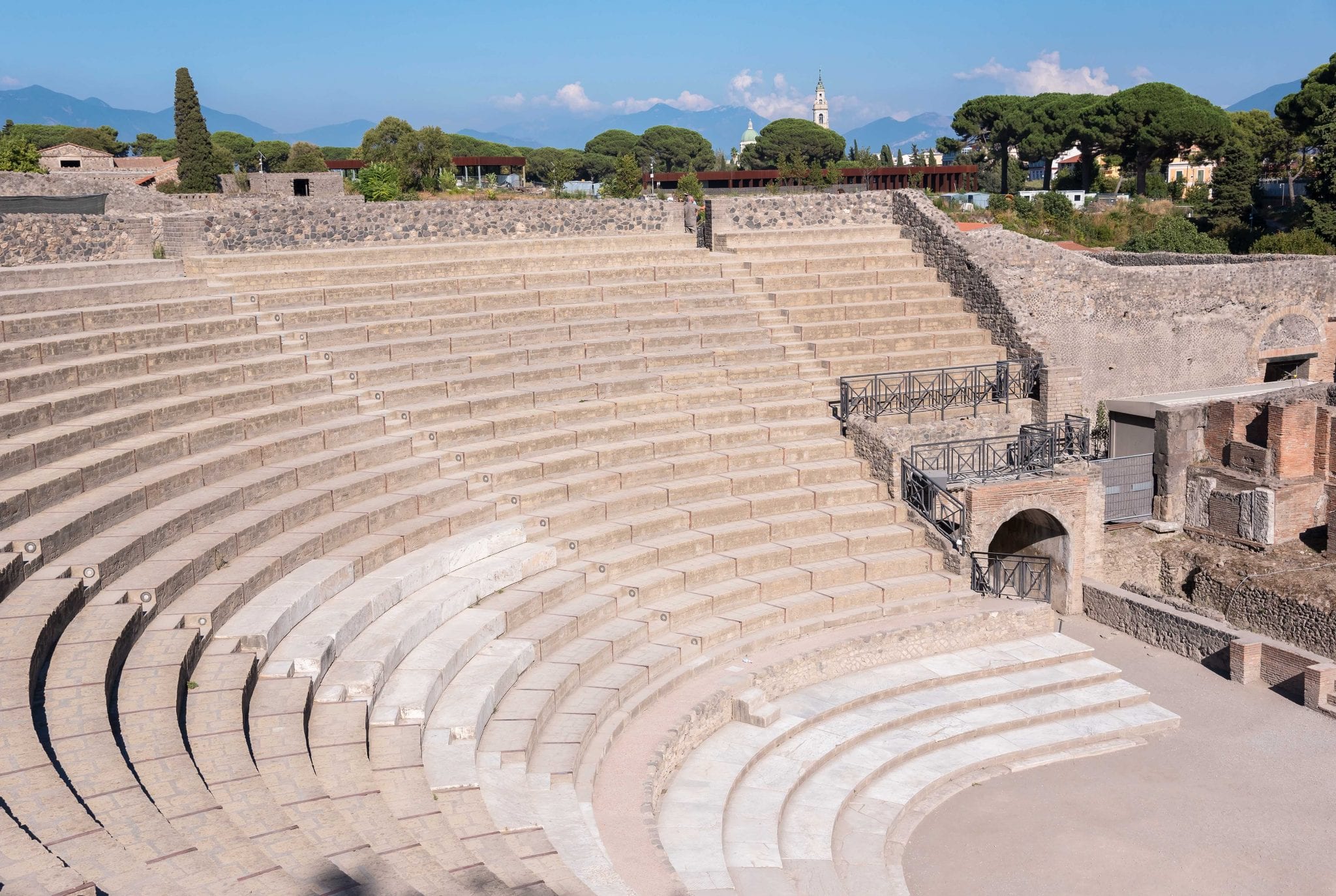
Pompeii’s magnificent Anfiteatro is the oldest-known Roman amphitheatre.
Homes, bakeries, restaurants, and brothels
You can also tour bakeries, small family restaurants, ancient roman homes and even a local brothel, where you can find “Umberto was here” style graffiti on the walls and lively life-sized frescos that served as a sort of ancient-day advertisements.
House of the Vettii
On the other end of the social class spectrum is the House of the Vettii, the home of a wealthy merchant and one of the best preserved homes. Though recently closed for renovations, if it’s open you can view the typical villa of ancient Pompeii’s richest citizens, including extravagant rooms covered in frescoes and an inner courtyard with small fish ponds.
Beyond Pompeii: Naples National Archaeological Museum
Many of the artifacts from Pompeii are housed in the Naples National Archaeological Museum since they were directly ordered to Naples in the 1700s by the Neapolitan king. History and archaeology buffs should absolutely visit the museum – it offers the best look into the art of Pompeii that still exists, which ranges from enormous statues and mosaics to intimate objects of every day life. Pompeii archaeological site has all of the ruins but the Naples Archaeological Museum houses all of the objects found during excavations.
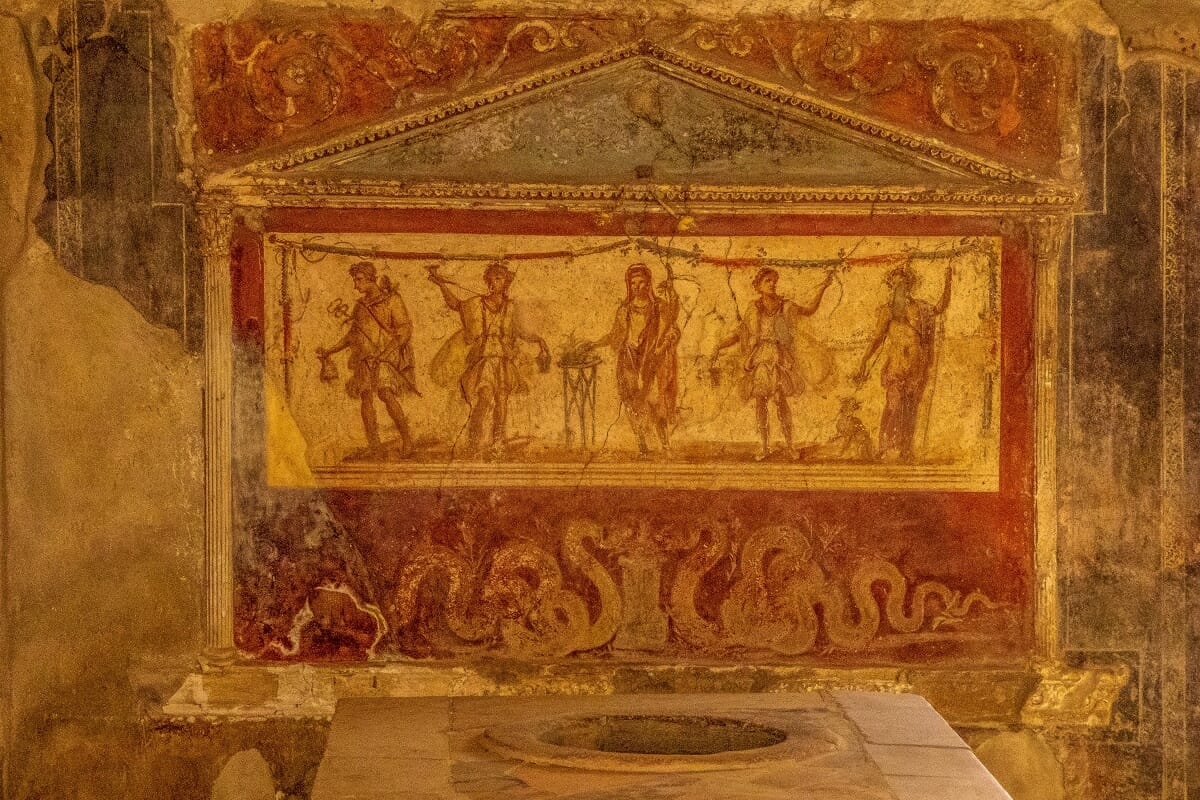
The Naples National Archeology Museum holds many gems lifted straight from Pompeii, such as frescoes and artifacts from everyday life. Photo credit: Nick Fewings
Before you end your visit to Pompeii, take a last look at the impressive view of Mount Vesuvius in the distance. 2,000 years ago the still-active volcano erupted a cloud of gas, ash and rocks. For hours it spewed, causing most of the residents to flee. It took just one moment for the eruption to change and an avalanche of lava and rock to race down the mountainside toward Pompeii. Though Vesuvius destroyed the city, it also effectively preserved it, stopping life in Pompeii in its track and providing us with most everything we know about the ancient town.
Want to explore the historic streets of Pompeii and traipse up and down the vineyards of Vesuvius? Join our Pompeii with Panoramic Winery Lunch on Vesuvius day trip from Rome.
by Gina Mussio
Book a tour.

Pristine Sistine - The Chapel at its Best
1794 reviews

Premium Colosseum Tour with Roman Forum Palatine Hill
850 reviews

Pasta-Making Class: Cook, Dine Drink Wine with a Local Chef
121 reviews

Crypts, Bones Catacombs: Underground Tour of Rome
401 reviews

VIP Doge's Palace Secret Passages Tour

Legendary Venice: St. Mark's Basilica, Terrace Doge's Palace
286 reviews
You May Also Like
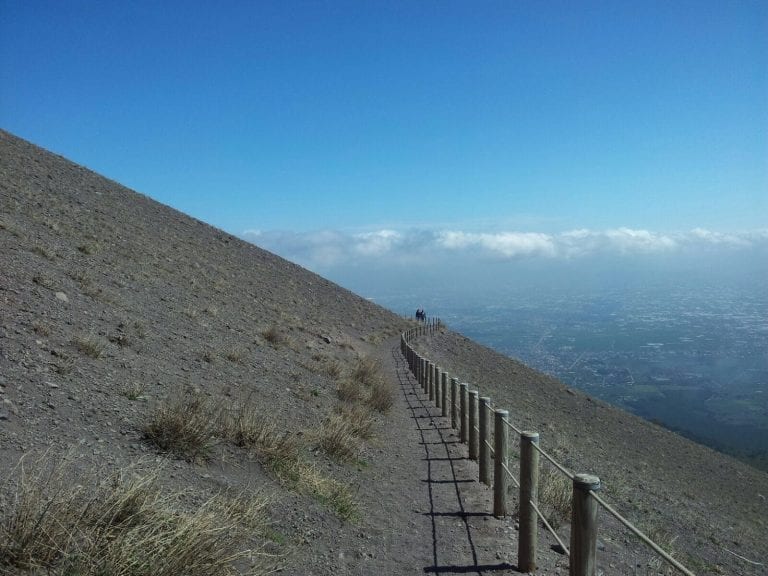
March 02, 2016
Why You Shouldn’t Go to Pompeii Without Visiting Mount Vesuvius
Ready why a visit to Mount Vesuvius is the best way to top off any trip to...
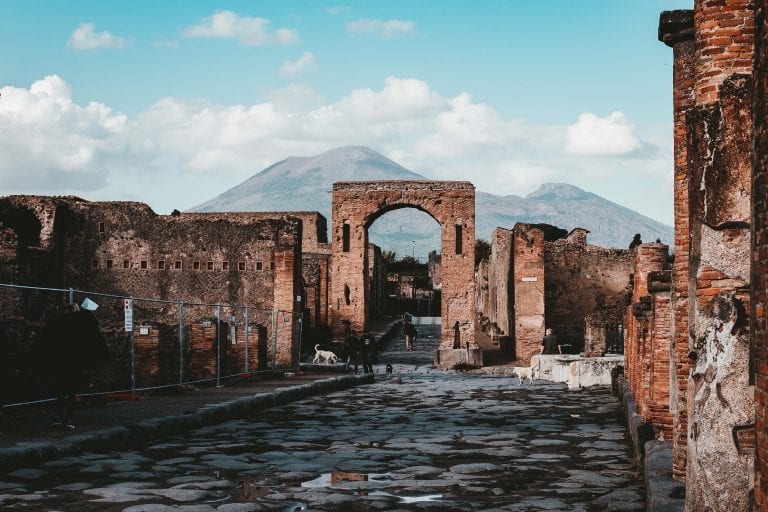
September 25, 2019
Pompeii Art Guide: Scandalous Frescoes & Mythic Retellings
Few things could be as fascinating to the historically minded as Pompeii – a town buried by the...
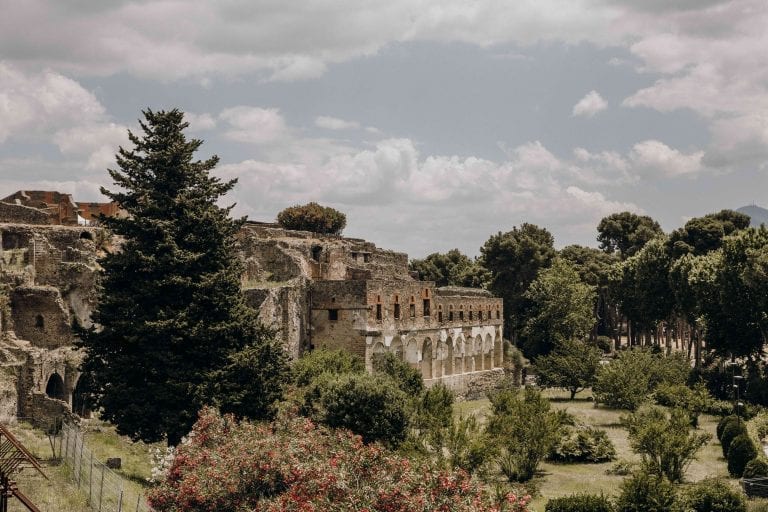
October 25, 2019
Pompeii Guide: 10 Things to Know Before Visiting the Ancient Roman City
One of the most famous Ancient Roman cities, Pompeii has become synonymous with history, as well as...

February 20, 2015
‘The Blonde Abroad’ Visits Pompeii & Positano
The Blonde Abroad discovers Pompeii and te Amalfi Coast with...
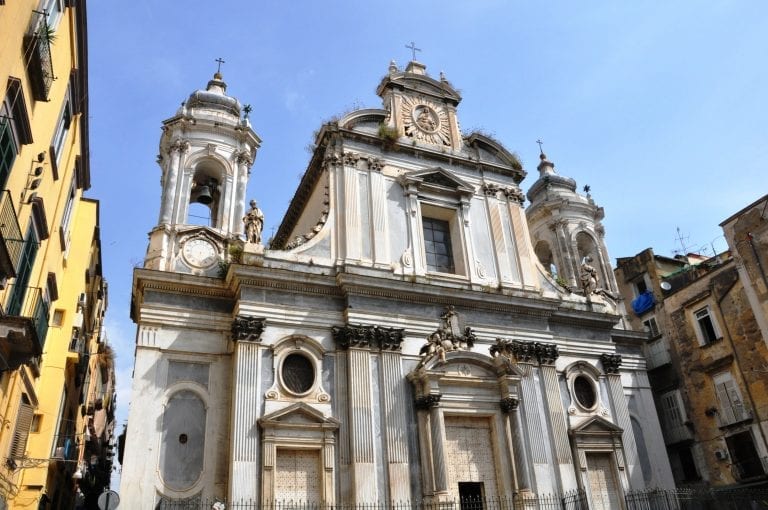
June 10, 2011
Why Visit Naples? 9 Reasons Not to Skip Napoli
Here's why you shouldn't miss Naples, that crazy city south of...

October 20, 2011
3 Best Eats Near Naples’ Train Station: Pizza, Pastries & More
Even if you only have 45 minutes between trains, you can still taste the best food in...
Stay up to date with travel tips, local insights and all things Italy on our social channels!
Subscribe to our Newsletter
Get curated Italy travel tips delivered to your inbox!
Your browser is out-of-date!
Update your browser to view this website correctly. Update my browser now
Institutional Portal of the Archaeological Park of Pompeii
- cambia lingua: Italiano
- cambia lingua: English
Timetables and tickets
All the sites are connected through a shuttle service, Pompeii Artebus ( Click here for details )
NB: The shuttle is equipped with storage for large luggage but is not equipped with disabled access.
(#) Admission cost of €2.00 for EU citizens between the ages of 18 and under 25. The reduced tariff is also valid for citizens of countries outside the European Union “holders of the residence permit in Italy issued for the reasons indicated on the website of the Ministry of Foreign Affairs”
(*) For those who are in possession of a Pompeii express ticket, additional access to the Suburban Villas route (Ville dei Misteri + Villa di Diomede + Villa Regina and Antiquarium in Boscoreale) is possible by purchasing an additional ticket at a cost of €8 – card payment only – directly at the start of the route at the Herculaneum Gate – Street of the Tombs entrance. Please note that the suburban villas route cannot be purchased individually, but only by either purchasing the Pompeii+ ticket (€22) or by supplementing the Pompeii Express ticket (€18) with an additional ticket (€8), which can be purchased directly – card payment only – at the start of the route at the Herculaneum Gate – Street of the Tombs entrance
click here for zoom of the map
Click here to enlarge the timetables
Closed on: 25 th December, 1 st May, 1 st January (Unless otherwise communicated. Click here )
From 6.00 pm reduced access in some domus. To consult the buildings which can be visited and their opening hours, please click here .
Free ticket every first Sunday of the month:
on these free Sundays (the first of every month), in order to prevent overcrowding which could put the safety and protection of both the site and visitors in jeopardy, and to optimise visitor flow, should the number of visitors exceed 15,000 by 12:00, the ticket offices will close for an hour.
Reduced (18-24 years old) and Free (under 18 years old and other specified categories) tickets cannot be purchased in advance. In this case, buyers will have to go to the Archaeological Park’s ticket office to show their document entitling them to free admission (identity card or other document proving the right to free admission).
The free ticket for a single access must be requested at the physical ticket office.
Community MyPompeii
Pompeii is renewing its annual pass for site visits at an even more competitive rate. It is a new way to experience Pompeii and the sites of the Archaeological Park, at a price which is affordable for all, and with the opportunity to participate in and to be informed about ongoing initiatives.
The MyPompeii card , which is valid for one year, it costs €35 (€8 for u n der 25s, 25 years not completed and EU citizens) + €1,50 online pre-sale and is valid for all of the sites of the Archaeological Park of Pompeii (Pompeii, the Villa of Poppaea/Oplontis, the Antiquarium of Boscoreale and Villa Regina, the Stabian Villas and the Libero D’Orsi Archaeological Museum/the Royal Palace of Quisisana).
Members of the MyPompeii community will receive advance notification of the latest news, as well as of the ordinary and extraordinary activities of the Park, will be able to interact and offer suggestions and proposals, and will also be invited to participate in an annual meeting with the Director of the Park, to be updated on current and future initiatives.
It will be possible to purchase the pass online at the www.ticketone.it website, for subsequent collection at the Pompeii ticket offices (at Porta Marina, Piazza Esedra and Piazza Anfiteatro). The card, which features the owner’s name and is non-transferable, will be valid for one year from the date of issue, and will – upon display of an identity document – permit unlimited admission to all sites of the Archaeological Park of Pompeii, as well as to current temporary exhibitions and to certain special and exclusive events, which will be communicated periodically.The card will be valid during ordinary opening days and times. Initiatives which are not managed by the Park and which are not included in the regular ticketing or scheduling will not be covered by the pass.
Those in possession of a pass which is still within its period of valid i ty will be able to take advantage of the same conditions as those pr o vided by the MyPompeii card.
The buildings that can be visited along the routes and their opening hours ( click here )
NOTICE – We invite visitors to carefully read all the information for accessing and using the site
INFO FOR THE VISIT
Entrance tickets can be purchased online at the website www.ticketone.it . The official ticket offices of the Pompeii Archaeological Park are located only within the archaeological area, at the entrances Porta Marina, Piazza Anfiteatro and Piazza Esedra .
We recommend purchasing tickets in advance to speed up entry to the Archaeological Park. Those who buy in advance will receive their ticket in PDF format, that can be printed out or shown on their smart phone, and they can go directly to the turnstiles at the entrance to the Archaeological Park.
It’s possible to purchase tickets for entry to Pompeii and other sites of Archaeological Park by phone . It’s possible to call 081 18658177 (email [email protected] ), from Monday to Friday, from 9.30 to 18.00. Telephone pre-sale cost €1.50 . It will be possible to pay with VISA, Mastercard, AMEX and, exclusively for Groups and Schools , also bank transfer. Tickets can be purchased at the following link: https://www.ticketone.it/help/outlets/
ACCESS TO THE SITE and VISITABLE BUILDINGS
It will be possible to enter the site from Porta Marina entrance, from Piazza Anfiteatro entrance and from Piazza Esedra entrance.
To access the Antiquarium, we recommend the entrance from Piazza Esedra which is included in the entrance ticket.
To consult the buildings which can be visited and their opening hours, please click here .
GUIDED TOURS
At the entrances of Porta Marina e Piazza Esedra it will be possible to request a guided tour service, from 9.00 to 15.00.
Groups that wish to visit the archaeological site of Pompeii, Villa Arianna and San Marco as well as the Libero D’Orsi Archaeological Museum at Stabiae, the Villa of Poppaea at Oplontis and the Villa Regina and Antiquarium at Boscoreale, that the size of these groups is regulated as follows:
- Pre-organised groups (tour operators / parishes / associations/ CRAL / company recreational initiatives and others) are permitted up to a maximum of 35 individuals if the group is equipped with earphones or ‘whisper’ systems, but are limited to a maximum of 15 individuals if the group does not have earphones or ‘whisper’ systems.
- For schools, class groups up to a maximum of 35 people (including accompanying individuals) are permitted without earphones or ‘whisper’ systems;
- Additional limitations on visitor group numbers may be imposed in smaller buildings or areas, or in case of particularly high visitor numbers, as advised by the Park Staff
APP MY POMPEII
In order to ensure a safe visit, we suggest the app MyPompeii (on Apple store or Google Play store) which, once downloaded, will allow you to scan the ticket QR Code and start the tour inside the site. You will also have the chance to view, on a map, in real time, the number of people visiting the site to avoid crowds.
The bookshop service is active at the entrance to Piazza Esedra and at Antiquarium.
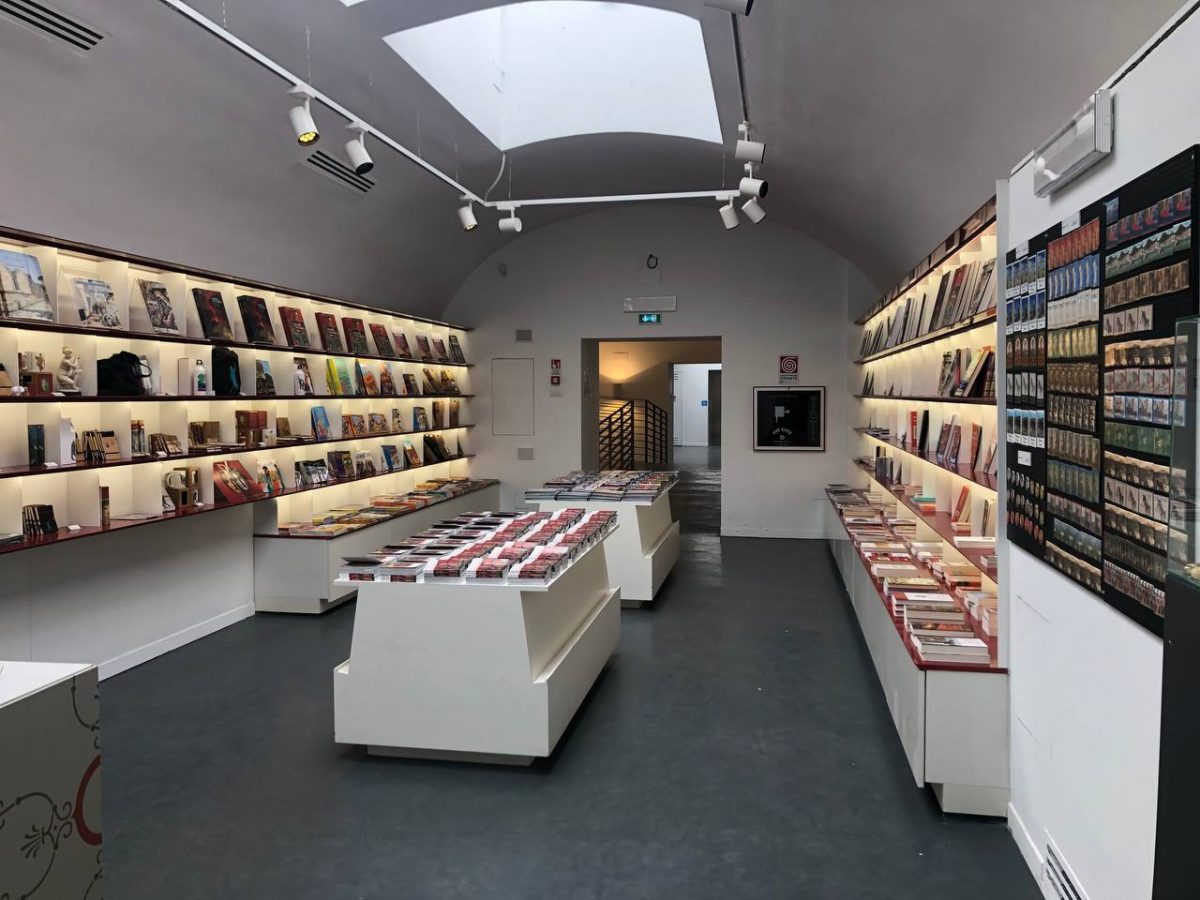
ACCESS FOR GUIDES
Guides will have access if they present their badge and only if they have a group of people following.
For personal entry, for study or inspection purposes, it is necessary to request at Ticket Office.
“POMPEII FOR ALL” ROUTE
with mobility difficulties, entering from Piazza Anfiteatro entrance, will be able to follow the facilitate “Pompeii for all” route, with the possibility of returning from the exit to Piazza Anfiteatro or possibly from Piazza Esedra, using the lift of the Antiquarium.
IT IS POSSIBLE TO PURCHASE THE ENTRANCE TICKET ON LINE AT THE FOLLOWING LINK
- Amalfi Coast
Visiting the Ruins of Pompeii
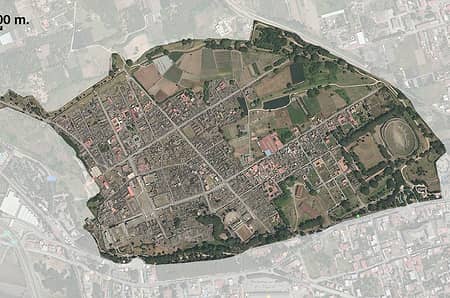
The archaeological ruins of Pompeii cover around 440,000 square meters, a vast area that would take at least three full days to explore completely. Remember that Pompeii is an entire buried city with squares, temples, baths, public buildings, private villas, and shops...just a visit to the city's forum takes about an hour.
That said, you can easily follow a shorter itinerary that includes some of the buried city's most famous sites , giving you an idea of what daily life was like in this Roman city. Here we suggest a few sites that you should include during your visit to the ruins, marking them with the same names as included on the free map provided at the ticket office and info point at the entrance to the ruins.
A Brief History of Pompeii
Pompeii was probably founded by the Oscans around the 8th century BC. This ancient Italic people settled on the southern slopes of Mount Vesuvius along the banks of the Sarno River, which was navigable at the time. Pompeii became an important commercial center early on, catching the interest of the invading Greeks and Etruscans. The Etruscans were conquered on the waters off Cuma, and the city came under domination by the Samnites in the 5th century BC. As a Samnite city, Pompeii entered into the Nucerine League and the tufo stone city walls were both expanded and fortified, allowing the city itself to grow. Pompeii became known as an important exporter of olive oil and wine, benefiting from the Mediterranean free market under Roman protection. After the end of the Samnite Wars in 80 BC, the city came under Roman dominance and in 89 BC Publius Cornelius Silla took up residency there along with a group of veterans, renaming the city Colonia Venerea Pompeianorum Sillana. During its Roman period, the city reached its architectural and economic peak, transforming into one of the most popular recreational and resort towns of the Roman aristocracy . During the Imperial Age, many wealthy Roman families moved to Pompeii, and buildings like the Temple of Fortuna Augusta and the Building of Eumachia are testimony to this influx. Under the Emperor Nero, the city was seriously damaged due to a strong earthquake in 62 AD, and rebuilding immediately began. Work was interrupted on 24 August of 79 AD by the disastrous eruption of Mount Vesuvius.
Visiting the Crater on Mount Vesuvius
A cloud, from which mountain was uncertain, at this distance (but it was found afterwards to come from Mount Vesuvius), was ascending, the appearance of which I cannot give you a more exact description of than by likening it to that of a pine tree, for it shot up to a great height in the form of a very tall trunk, which spread itself out at the top into a sort of branches; occasioned, I imagine, either by a sudden gust of air that impelled it, the force of which decreased as it advanced upwards, or the cloud itself being pressed back again by its own weight, expanded in the manner I have mentioned; it appeared sometimes bright and sometimes dark and spotted, according as it was either more or less impregnated with earth and cinders." (Pliny the Younger)
Excavation of Pompeii began in 1748 under King of Naples Charles III of Bourbon , who was interested in the project's prestige for the royal house and did not undertake the dig with particular scientific or systematic vigor. During the French occupation at the beginning of the 19th century, work at the excavation increased, though was halted almost completely with the return of the Bourbon kings. During this period, the discovery of the House of the Faun , with its excellent mosaic depicting the Battle of Alexander at Issus created such a stir that archaeological work began again at the site, this time using scientific methodology, careful record keeping, and plaster casting. From 1924 to 1961, work was overseen by Italian archaeologist Amedeo Maiuri and included important discoveries. Over recent years, excavations of new areas in the site have been halted and work is concentrated on restoring and maintaining buildings already unearthed.
2 Hour, 4 Hour, and 7 Hour Itineraries
Sites to visit from the Porta Marina Inferiore Piazza Esedra entrance (the second entrance from the Circumvesuviana “Pompei Villa Dei Misteri” stop along the Sorrento - Naples line )
- Quadriporticus of the theatres or Gladiators Barracks (VIII - 11)
- Large Theatre (VIII - 10)
- Small Theatre - Odeon (VIII - 12)
- House of the Menande ( I - 7)
- House of Casca Longus (I - 2)
- Fullery of Stephanus (I - 3)
- House of the Lararium of Achilles (I - 4)
- Garden of the Fugitives (I - 16)
- Necropolis of Nocera Gate (II - 10)
- Amphitheater (II - 5)
- Praedia of Giulia Felice (II - 3)
- House of Venus in the shell (II - 2)
- House of Octavius Quartio (II - 1)
- House of the Epidii (IX – 5)
- Stabian Baths (VII - 16)
- Lupanar (VII - 18)
- House of the Faun (VI - 1)
- House of the Vettii (VI - 11)
- House of the Golden Cupids (VI – 12)
- House of the Ara Maxima (VI – 13)
- From Torre XI up to Herculaneum Gate (VI - 16)
- Villa of the Mysteries (VI - 19)
- Forum Baths (VII - 10)
- Forum (VII – 6a)
- Temple of Jupiter (VII - 8)
- Forum Granary (VII - 7)
- Basilica (VIII - 2)
- Sanctuary of Venus (VIII - 1)
Porta Marina Superiore exit
Top 10 Area + number on the official map in parenthesis
Visiting Pompeii ruins with Kids
It isn't easy to get around Pompeii ruins with a stroller or pushchair, as the ancient Roman roads that cross the city are not navigable on wheels. Wheelchair users can follow a special marked route with the free map provided at the entrance, and the same itinerary can be followed with a stroller. Regardless, the best way to visit with infants and young children is by using a carrier or backpack. There are a number of Baby Points inside the archaeological park, which are small bungalows marked on the map. You can request keys at the park entrance and use these spaces to change and feed your infant in complete privacy.
Where to Eat
If you have decided to dedicate a full day to Pompeii ruins, the best option for lunch is packing a picnic to eat inside the park . On the park map available at the entrance, you will find a number of picnic areas marked around the ruins. Large bags are not allowed inside, so you will have to pack your food and beverages in small bags or backpacks. Purchase your supplies in Naples or Sorrento, as the snack bars inside the park are expensive. In Sorrento , the Salumeria Aprea (located on Via Tasso in the historic center and at the beginning of Via del Mare) makes excellent Caprese sandwiches and often has “casatiello”, a soft savory bread baked with diced ham, traditionally made at Easter. In Naples , pick up a sandwich at a cafè or take-away near the Stazione Centrale, or stop in Eccellenze della Costiera to choose some traditional sweet treats from the Amalfi Coast .
For a sit-down meal: Hortus (tel: +39 081 536 4566) Located along the road between the train station and the Porta Marina entrance, this spot is popular among tourists and offers a number of take-away options for a light lunch, or local dishes served in the pleasantly cool citrus garden. Caupona (tel: +39 081 1855 7911) If you want to stay on point, walk 5 minutes from Villa dei Misteri to this restaurant opposite Piazza Esedra that serves ancient recipes created by the Roman gourmet Marcus Gavius Apicius and served on terracotta plates by waiters dressed in period garb against the background of ancient music and frescoed walls inspired by Pompeii.
Top Ten Pompeii Sites
1. large theater and odeon (viii - 10).
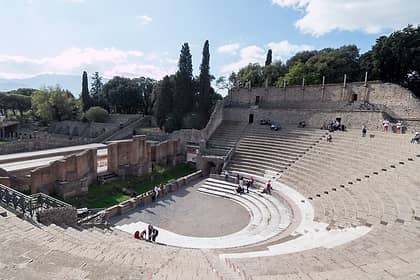
Pompeii's two theaters are located in the same area of the ancient city. The Teatro Grande (Large Theater) is an open-air amphitheater where Greek-Roman plays were performed; the smaller Odeon was used for poetry and musical performances, which required a smaller and covered space for the best acoustics. Tip: stand at the middle of the Odeon's stage and speak in a normal voice. You will hear your own voice amplified as if you have spoken into a microphone.
2. Garden of the Fugitives (I- 16)
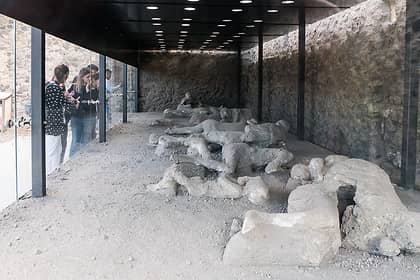
The Orto dei Fuggiaschi (Garden of the Fugitives) was an old quarter of the city that has been converted to vineyards as Pompeii grew. The name is an homage to the bodies of 13 victims of the eruption in 79 AD who were trying to escape through Porta Nocera before succumbing to the ashes and stone. Their remains where discovered during excavations in 1961-62 and 1973-74, using plaster casting methods.
3. Amphitheater (II – 5)

Built around 70 BC, Pompeii's ancient amphitheater is one of the best preserved in the world. Used for sporting events and gladiator battles, the space could seat 20,000 spectators in three sections of seating: the first rows were for prominent citizens, the middle rows were for the middle classes, and the summa, or the highest rows, were for the rest of the population.
4. Praedia of Giulia Felice (II – 3)
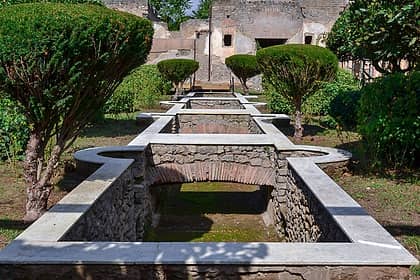
The Praedia di Giulia Felice is a large complex dating from the 1st century BC and was one of the first homes unearthed during excavations. This patrician villa has a large gardens surrounding a series of residential buildings and thermal baths. The name Giulia Felice was taken from an inscription painted on the facade after the earthquake of 62 AD (today displayed in Naples' National Archaeological Museum) in which the owner advertises that part of the property is for rent. The lavish decorations in the residential and thermal areas are particularly beautiful.

5. Lupanar (VII - 18)
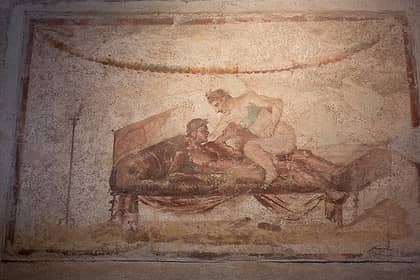
The lupanare (lupanar) is one of the most memorable sites within the ruins of Pompeii. The city's brothel was on two levels, with five small cells on the ground floor and five upstairs. Each cell had a stone bed that was topped with a mat or cushion, and above the door of each cell was an erotic fresco that probably depicted the specialization of the prostitute that worked in each individual cell. Though the brothel is located between two side streets, it was and still is easy to find by following the phallic symbols on the flagstones and facades of nearby buildings.
6. House of the Faun (VI – 1)

The Casa del Fauno (House of the Faun) is one of the most spectacular and largest houses in Pompeii, covering around 3,000 square meters with areas dedicated to the villa's owners and other areas for the servants. The name comes from a bronze satyr statue in the impluvium (a small pool for gathering rain water), and the villa has a number of statues, frescoes, and mosaics. Among the most famous is the mosaic that depicts Alexander the Great battling Darius and the Persians at Issus, now displayed at the National Archaeological Museum in Naples.
7. Villa of the Mysteries (VI – 19)
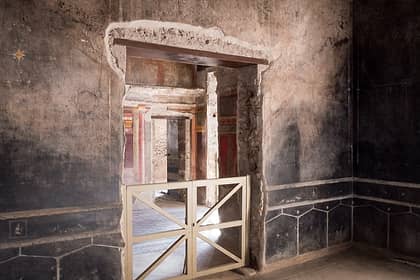
Discovered between 1909 and 1910, the Villa dei Misteri (Villa of the Mysteries) is one of the most captivating and mysterious in the entire ruins, and probably belonged to the Istacidii family, one of the most powerful in Pompeii during the reign of Augustus. The building dates from the first century BC and was built in the western residential area outside the city walls overlooking the sea. It had been renovated a number of times before the eruption in 79 AD, and is named for the Hall of Mysteries, a triclinium (dining hall) decorated with an extraordinary and enigmatic cycle of paintings,17 meters by 3 meters. The scene seems to depict a Dionysian ritual and the initiation into the cult, with the gods Dionysus and Aphrodite (or Ariadne) in the center of the rear wall.
8. Forum (VII – 6a)

Pompeii's Foro (Forum) is one of the most striking spots in the ancient city: a large square with triumphal arches, public buildings, the basilica, the market, the mensa ponderaria (weights and measures), and temples and buildings dedicated to Apollo, to Jupiter (the head of the former statue, dating from around 80 BC, still sits here), to Vespasian, to the Public Lares, and the Eumachia building. The city's main civic, religious, and commercial activities were carried out in the forum, and, as in all Imperial cities, the space was pedestrian only and closed to wheeled vehicles.
9. Basilica (VIII – 2)

Don't be fooled by the name: in Roman times, a basilica was the most important public building in the city, used as a type of courtroom where the judge sat on a raised dais above the sides and was also where commercial contracts were drawn up. The space, dating from the second century BC, resembled a covered forum with columns and could be used for the same civic, religious, and commercial functions in case of inclement weather.
10. Sanctuary of Venus (VIII – 1)

This important sacred site dedicated to Venus, protectress of the city and of navigation, was established in the second half of the second century BC on the plain of Pompeii facing the Sarno Valley and the sea. In the first half of the first century AD, the building reached its height of splendor with a series of expansions, renovations, and marble decorations. The temple housed a large gold lamp, probably donated by Nero and his wife, Poppea, to the cult, now displayed in the National Archaeological Museum in Naples .
Pompeii ruins Photo Gallery
FAQ - Frequently asked questions
Is the audioguide included in the ticket.
The cost of the audioguide is not included in the entrance ticket. While purchasing Pompeii tickets, you will be able to see all the options available to purchase together with the entrance ticket, such as audio guide, 3D eyelashes with all related explanations, etc.
Do the tickets have a binding entry time?
Skip-the-line tickets for Pompeii Ruins are valid for the whole day. Bear in mind, however, that the last entry to the site is an hour and a half before closing time.

Ultimate Guide To Visiting Pompeii In 2024: 20 Things To See + Tips
Pompeii is a UNESCO-listed archaeological site located just 30 minutes from Naples.
It was once a thriving ancient Roman city. But in 79 A.D., it was tragically buried under layers of volcanic ash and debris when Mount Vesuvius suddenly erupted.
Rediscovered centuries later, Pompeii offers a unique glimpse into the daily life, art, and architecture of ancient Roman civilization.
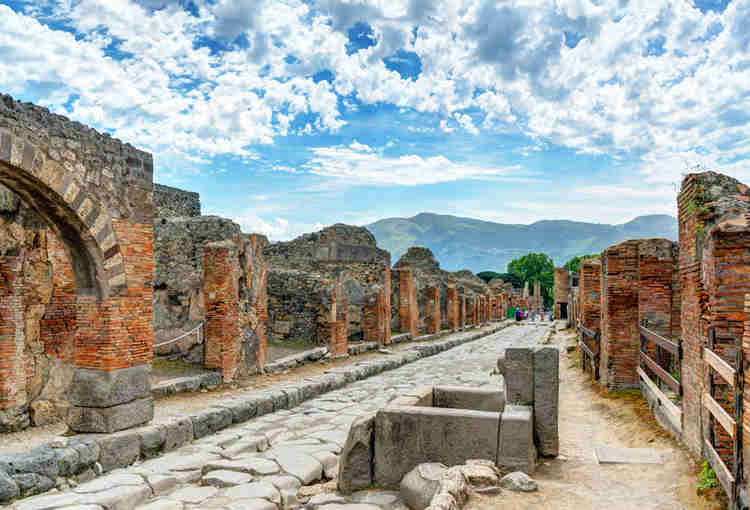
In this guide to visiting Pompeii, I take you on a journey through the streets of Pompeii. I describe 20 of the must see highlights. I also give you essential information, tips, and insights to help make the most of your visit.
New things are discovered all the time. So, if you’ve been, a repeat visit may be in order.
Tickets & Tours For Pompeii
For a visit to Pompeii, you need to plan ahead. Pompeii is one of the most popular attractions in Italy. You’ll need to book tickets and tours in advance.
When you arrive, there will be two lines: one for people with tickets and one for people who need to buy tickets.
Unless you’re visiting in the winter, I would be sure to book a skip the line ticket in advance. Even then, you will have to wait in line for awhile just to get through. Be sure to grab a map when you enter.
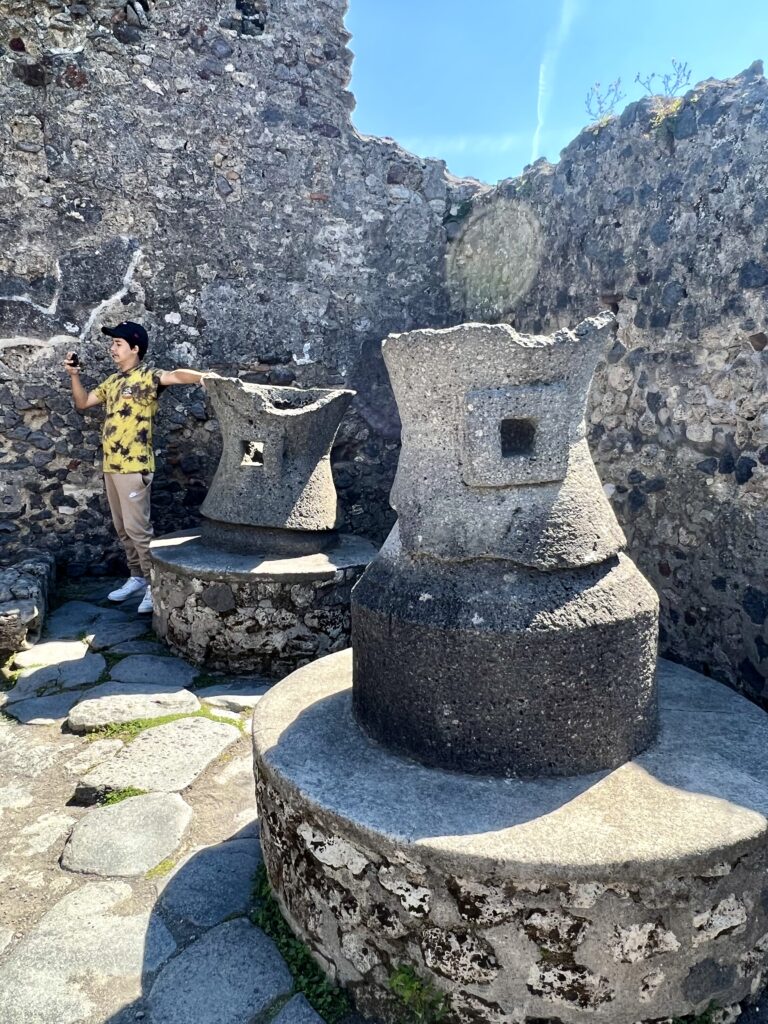
Should You Book A Guided Tour?
Unless you’re a Romanologist or just prefer to roam on your own, I recommend booking a guided tour with an expert. Pompeii is a complicated site and there’s a lot to see.
You can have a more relaxed visit with an expert. Plus, they will take care of obtaining tickets.
Having a guide is especially important if you have limited time in Pompeii. A tour guide will get you to the main highlights in a fast and efficient way.
Over the years, I’ve visited Pompeii three, by myself twice and once in a small group. This time I booked a private tour and was glad I did. There were just so many newly renovated sites to see in Pompeii.
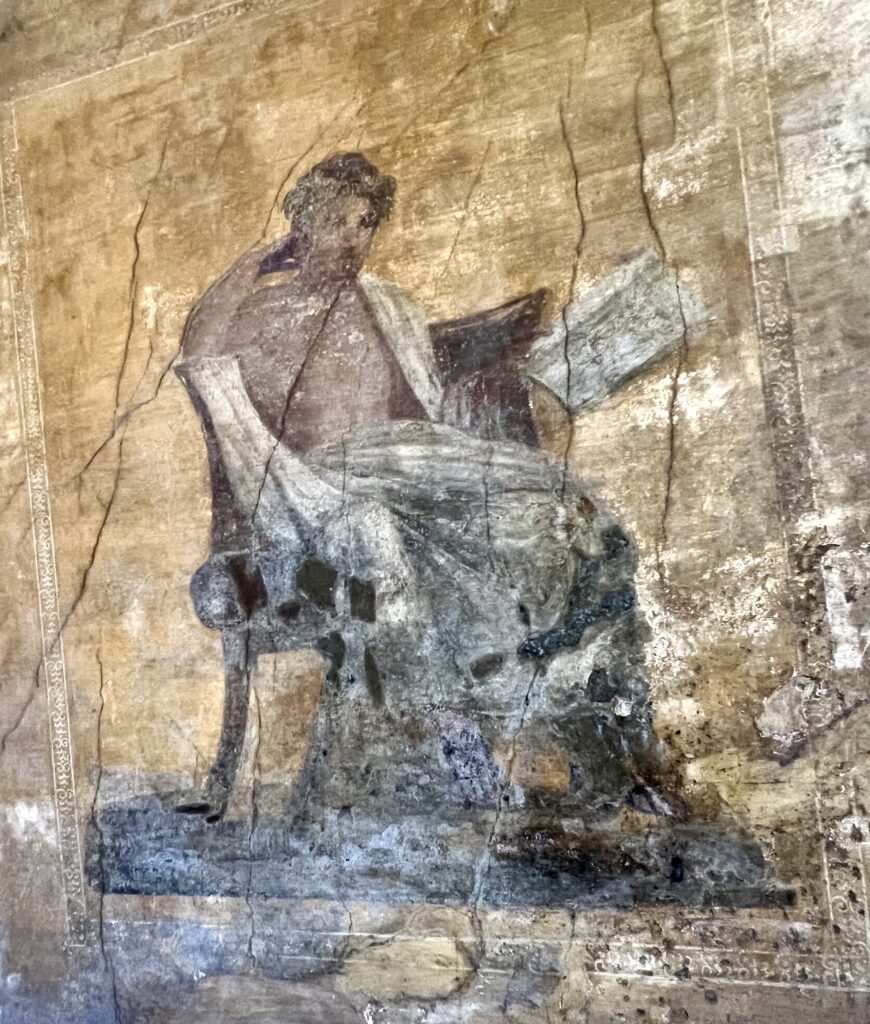
Having a guide has some decided advantages. First off, our guide pulled us straight through the rather long line at the entrance for tickets and a security check.
With a private tour, you can also select the sites that you want to see most. For example, this time around, I really wanted to see the newly-renovated frescos at the Villa of Mysteries and the recently-opened House of the Vettii.
But they aren’t on any standard tour because they’re outside the center (Vettii) or in the “suburbs” (Mysteries).
You should also consider the length of the tour when booking one. Almost every tour lasts 2 hours. If that’s all you have, try to book a tour with an archaeologist to get the most bang for your buck.
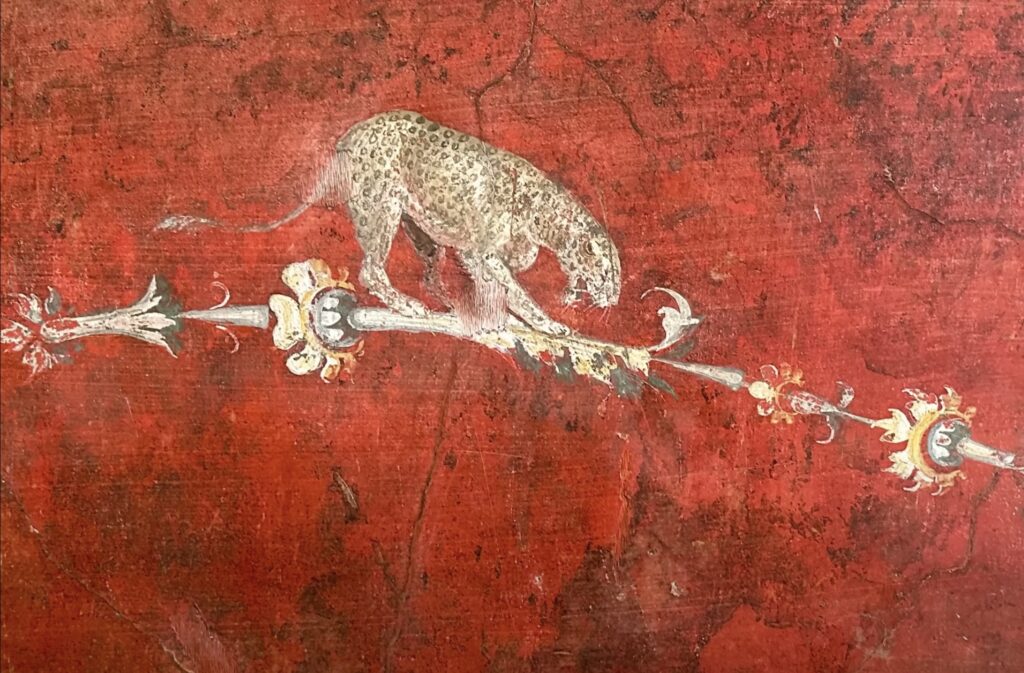
You can only skim the highlights of Pompeii in 2 hours. Depending on your expectations, you might come away a tad unsatisfied. But you can always stay longer after your tour is over, if time permits.
I had a friend who recently visited and was disappointed not to see more frescos. But that’s the thing. Most of them are not on a standard tour.
Here are some tours you might consider booking that are 3+ hours:
- 3 hour private tour with an archaeologist
- guided tour tour from Naples of Pompeii and Herculaneum with an archaeologist
- 6 hour private tour of the Pompeii and the Naples Archaeological Museum
- 10 hour private tour from Rome
You can also arrange a guide at the main entrance of Porta Marina.
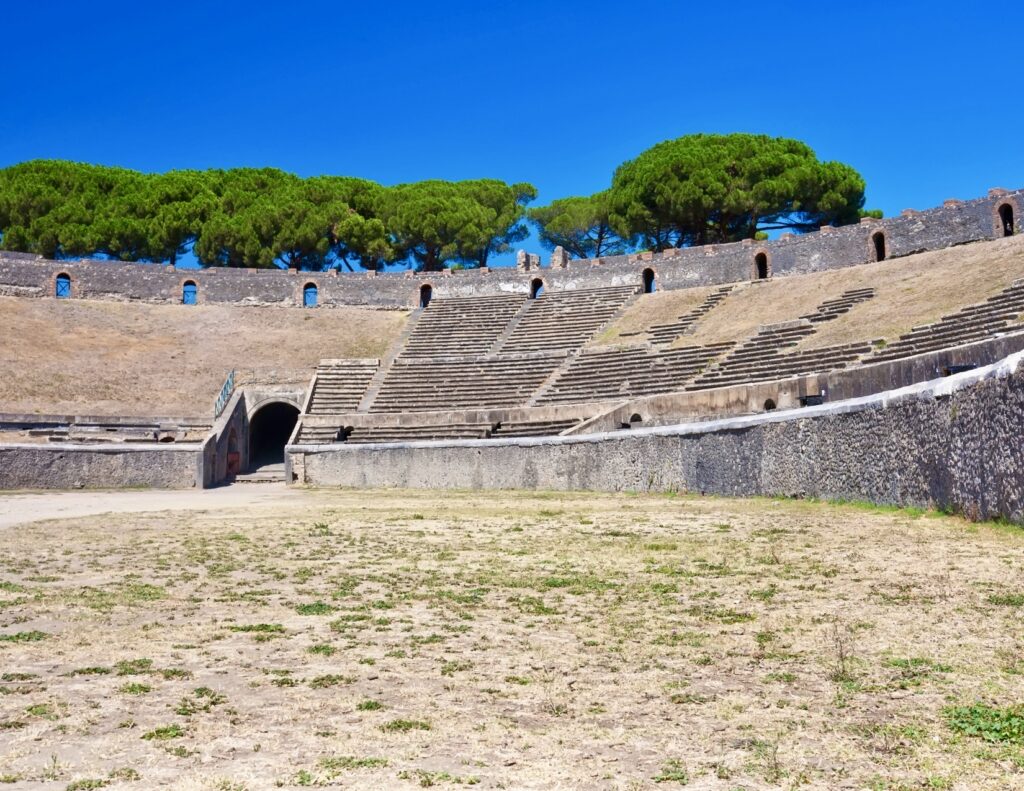
Guide To Pompeii: 20 Things To See
Here are the 20 best and most important things to see in Pompeii.
1. Amphitheater
While not as grand as the Colosseum in Rome, Pompeii’s well-preserved amphitheater dates from 70 B.C. It could seat up to 20,000 people and was one of the largest Roman amphitheaters of its time.
The amphitheater is a large oval building. It was built to host gladiatorial games, animal hunts, and other spectacles.
The brick exterior is characterized by a series of arches or arcades. They form a continuous ring around the outer walls. They served as entrances and exits for the spectators and helped facilitate crowd flow.
As with the Colosseum, the seating was divided into different sections based on social class. There was also an underground area, called the hypogeum, where gladiators prepared for the games.
READ : Guide to the Colosseum in Rome
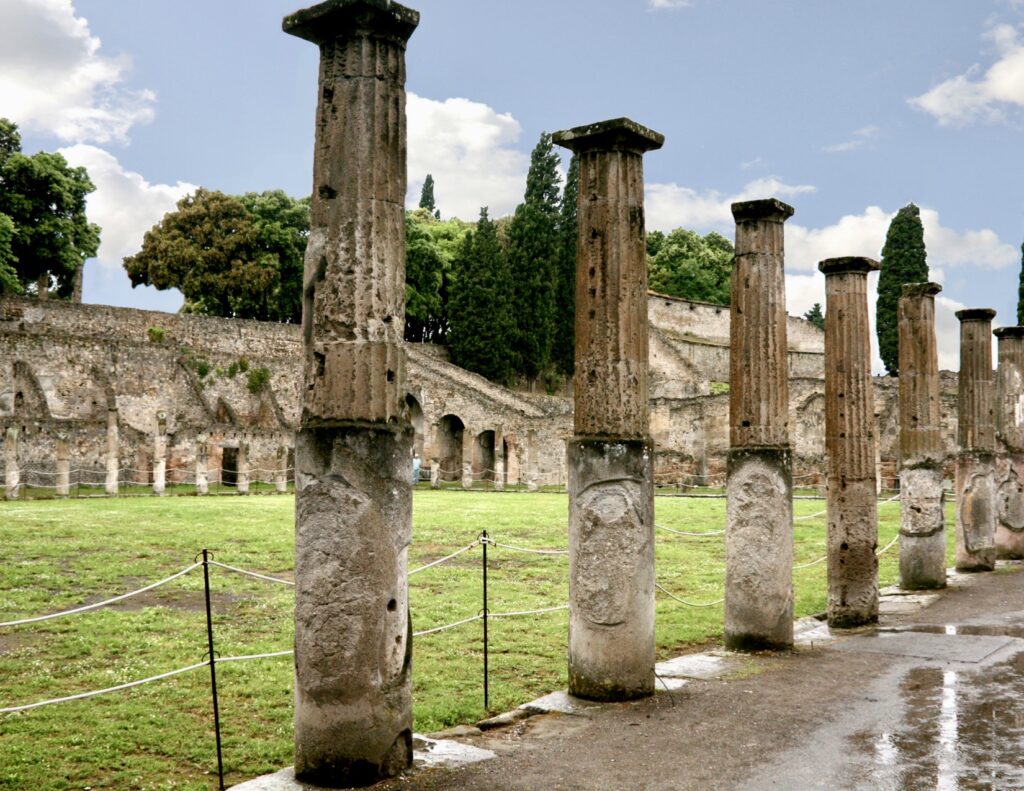
2. Great Palestra
Right next to the amphitheater, this “great palace” was the gymnasium of the gladiators. It’s a large rectangular open-air courtyard that served as a training ground for gladiators and athletes during ancient Roman times.
The central courtyard is surrounded by porticoes where the gladiators would rest during training sessions.
The courtyard itself was used for various physical activities, including combat training, wrestling, and exercises to improve strength and agility.
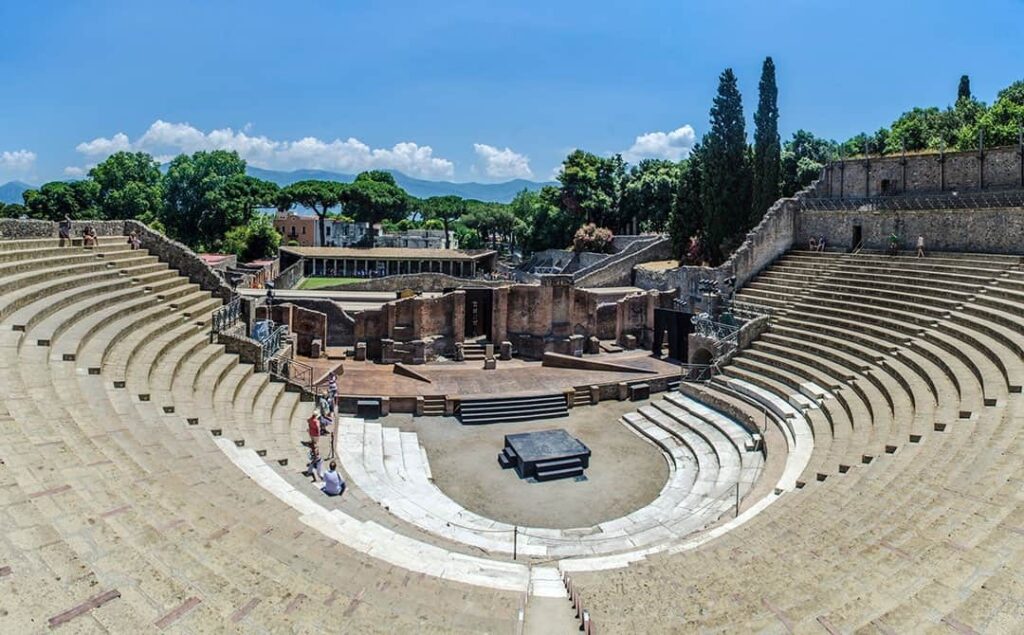
3. Teatro Grande
Once covered in marble, Teatro Grande was Pompeii’s second largest theater. It had seating for 5,000 people. It was essentially the “Broadway” of Pompeii.
The theater hosted musicals, Greek tragedies, comedies, and other dramatic performances. It was conveniently located next to the fast food joints, so citizens could get a quick meal before or after show time.
You should climb to the top of the seats for views of the ruins.
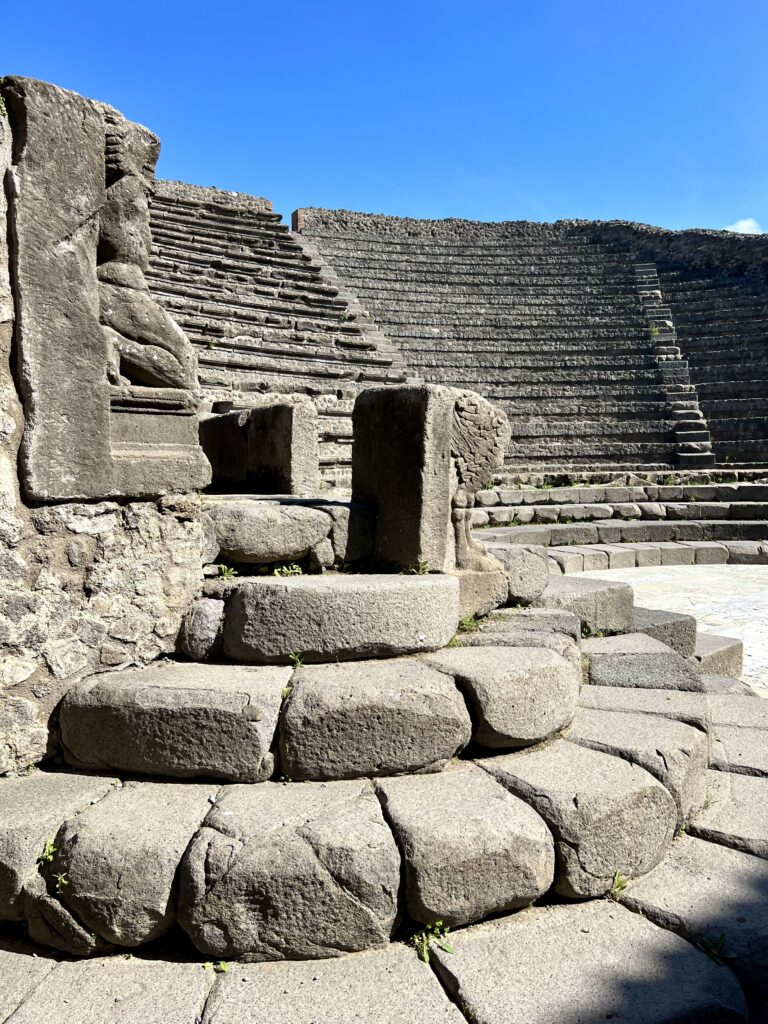
4. Teatro Piccolo: Odeon
Teatro Piccolo was the smallest of Pompeii’s three theaters. Dating from the 1st century B.C., it was an intimate venue with only 800 seats.
It once had a domed roof and remarkable accoustics.
The theater hosted musicals. It was likely used for special performances for the aristocracy.
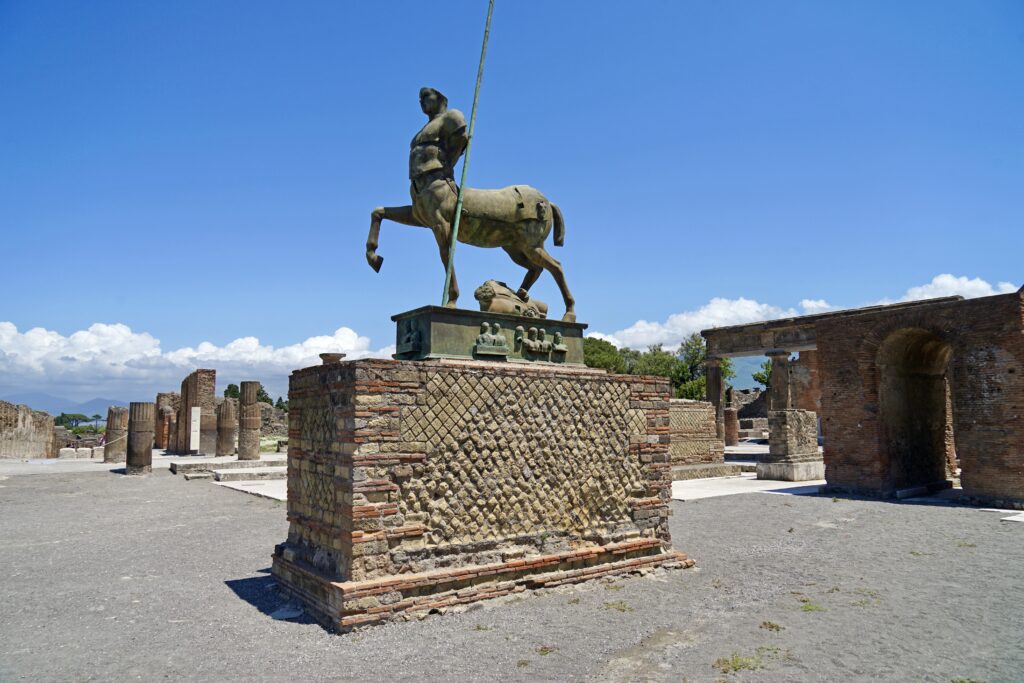
5. Forum of Pompeii
As with every Roman town, the forum or foro was Pompeii’s main square. A colonnade with loggias ran along three sides. You can see Mount Vesuvius looming in the distance.
The two triumphal arches you see are from the Temple of Jupiter. He was the chief god in the Roman pantheon of gods.
In the forum, you will also find the ruins of a wool factory and a covered meat and fish market.
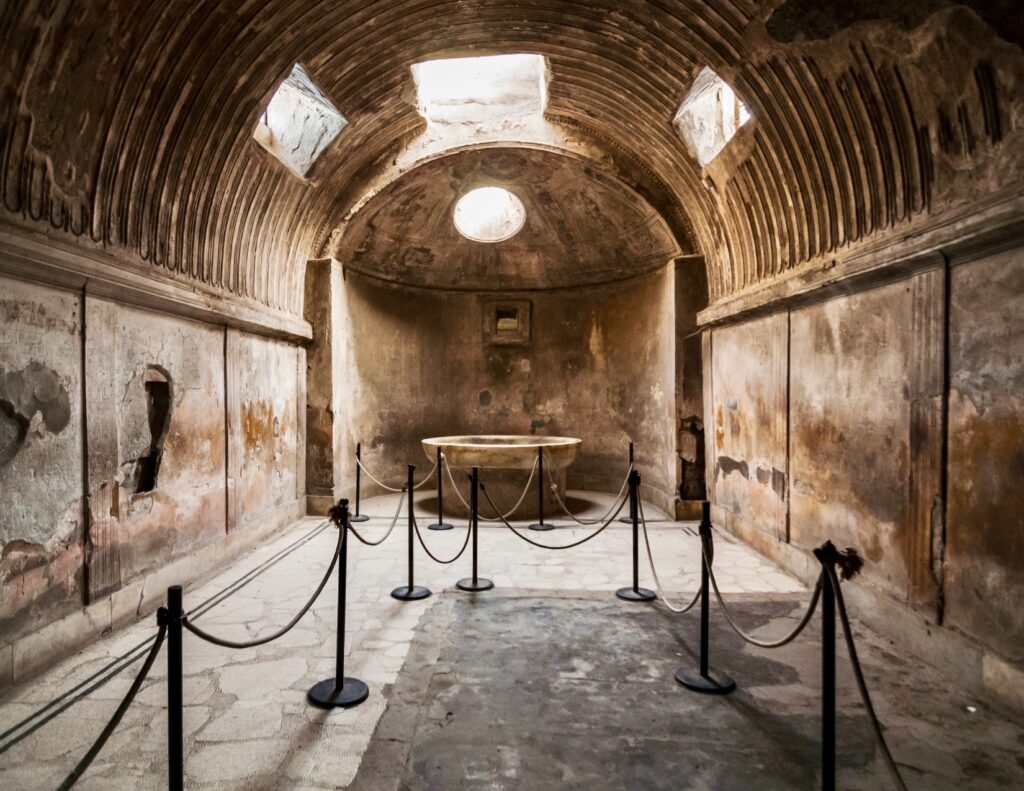
The forum was also home to some large baths. There was a changing room, frigidarium , tepidarium , and caladium . Like most Roman baths, the caladium had a hypocaust system, or underfloor, heating system.
The baths were once adorned with beautiful frescos and marble decorations. It was also home to a library, gymnasium, and shops.
The forum granaries house a vast collection of over 9,000 artifacts unearthed during excavations. You’ll see vessels, terra cotta pottery, and amphorae jars.
You’ll also come face to face with Pompeii’s victims when you see the haunting plaster casts. This is where you will see the poignant cast of a man who tried to cover his mouth to prevent toxic gases from getting in.
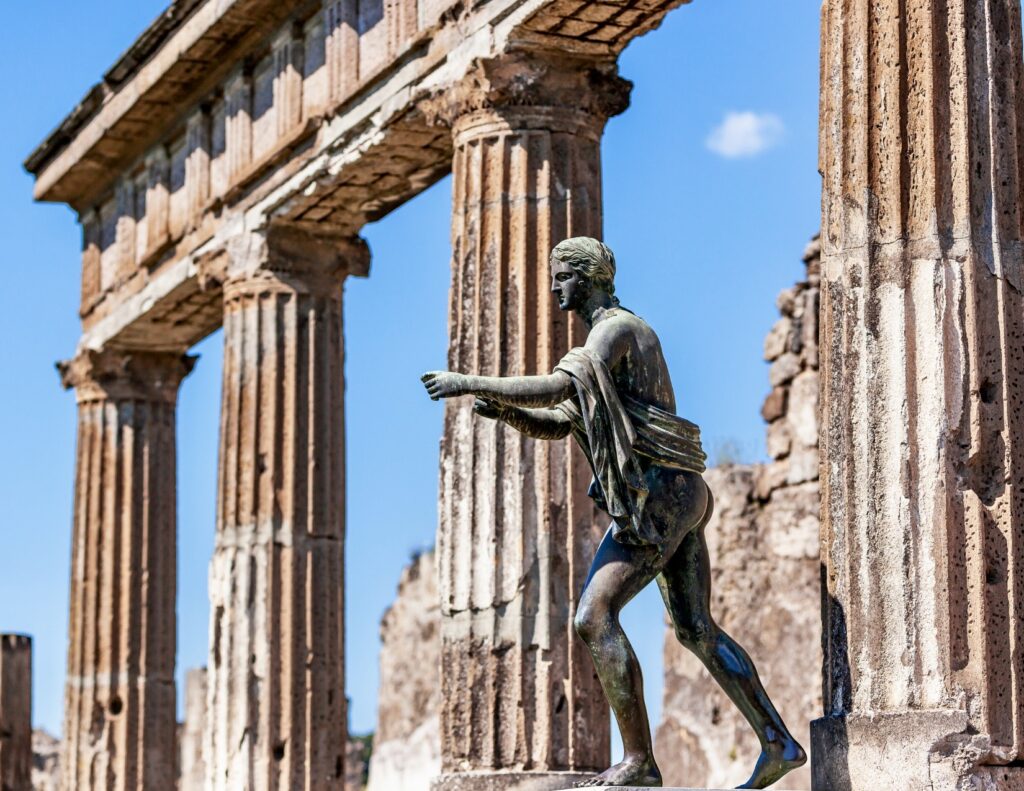
6. Temple of Apollo
The forum’s Temple of Apollo is Pompeii’s oldest religious building. It has a fairly standard design with a portico and pediment support by Corinthian columns.
It was once used for religious ceremonies and festivities dedicated to the cult of Apollo. Statues of Apollo from the temple are now housed in the Naples National Archaeological Museum , with many of the other treasures from Pompeii.
Just to the right of the temple is the Basilica. It was once home to the law courts and public offices.
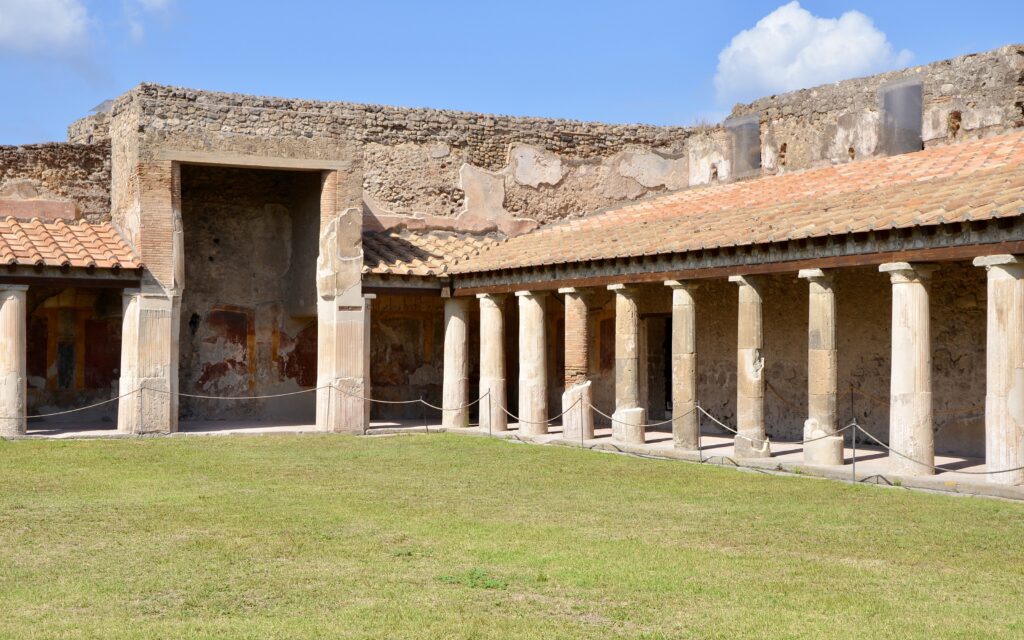
7. Stabian Baths
The Stabian Baths are the oldest and largest bath complex in Pompeii. They were named after the Stabian Gate, which is located nearby.
The baths are a large complex with several different sections.
They consist of a vast central courtyard surrounded by various rooms and chambers: changing rooms, hot and cold baths, saunas, and exercise areas.
READ : Guide to the Baths of Caracalla
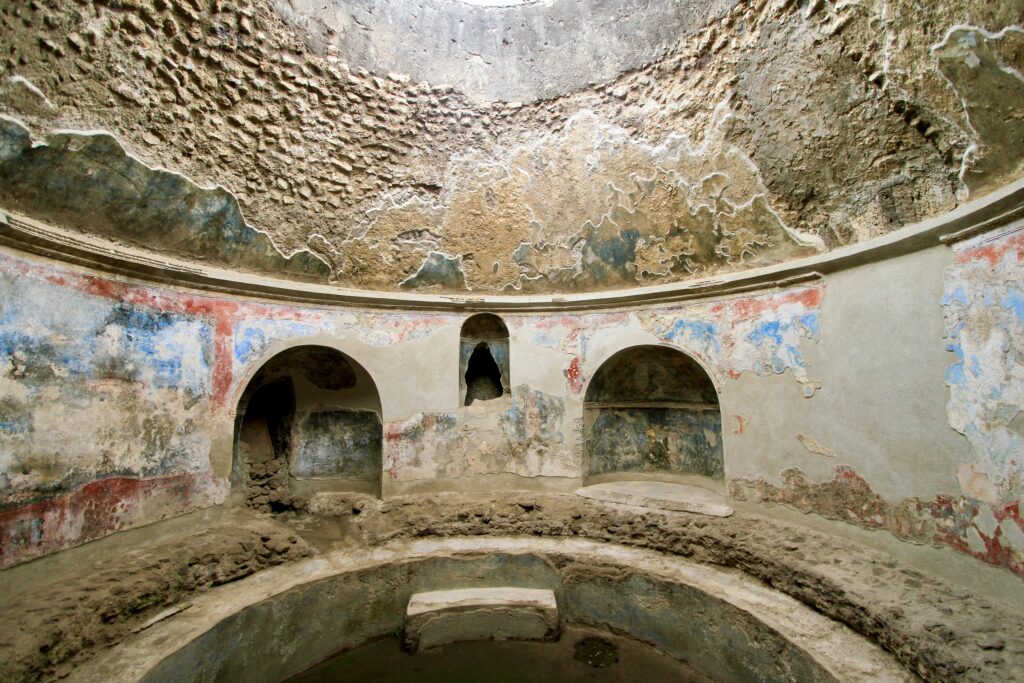
Like all Roman baths, the baths served as an important social and cultural hub, They were a place for relaxation, socializing, and maintaining personal hygiene.
The baths were once adorned with beautiful frescoes and mosaics that depict scenes from mythology, everyday life, and nature. Some remnants of them remain on the walls and ceilings.
The stucco decorations are particularly impressive. There are a range of pigments in blue, yellow, red, and green. They were intended to add an air of opulence to enhance the bathing experience.
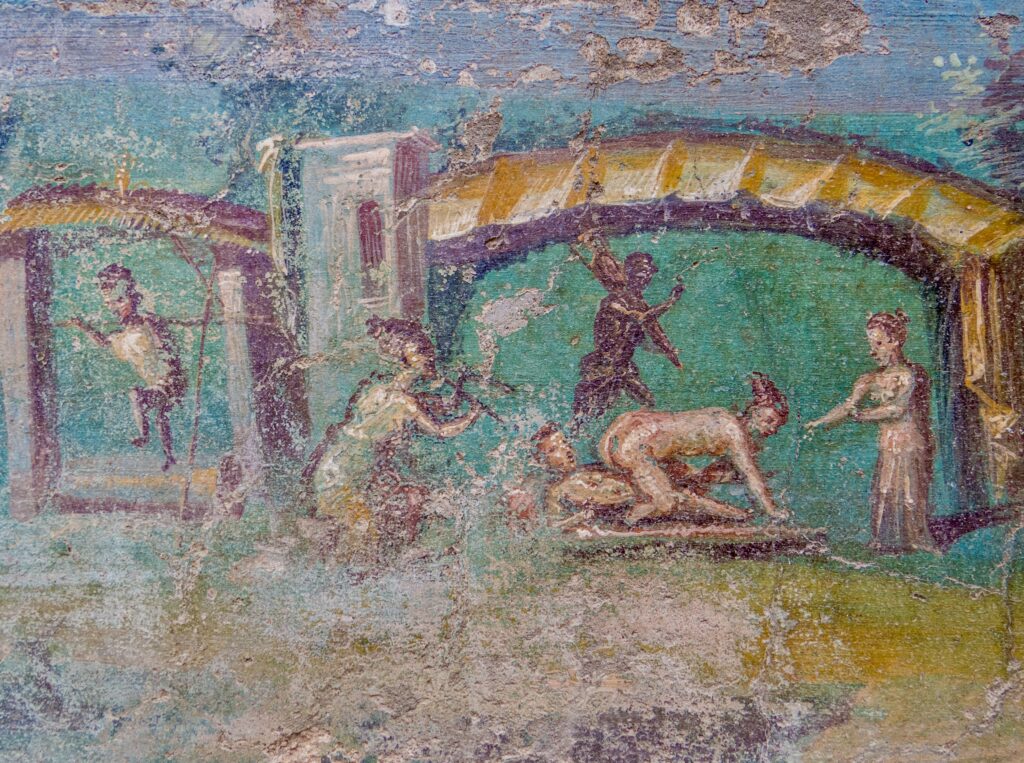
It’s estimated that there were between 25-35 brothels in Pompeii. The main one to see is Vitolo del Lupanare just off the main drag (Via dell’Abbondanza).
You will know you’ve arrived when you see a penis marked in the pavement. This is one of the most popular attractions in Pompeii. Prepare for crowds and lines.
Frescos above each doorway indicated the specialty of each prostitute. In Ancient Rome, prostitution did not carry a stigma. It was part of everyday life.
If there is a long line to enter the brothel and you don’t have much time, I would recommend skipping it. The brothel is rather basic and definitely not worth a long wait. There are better sites to see in Pompeii.
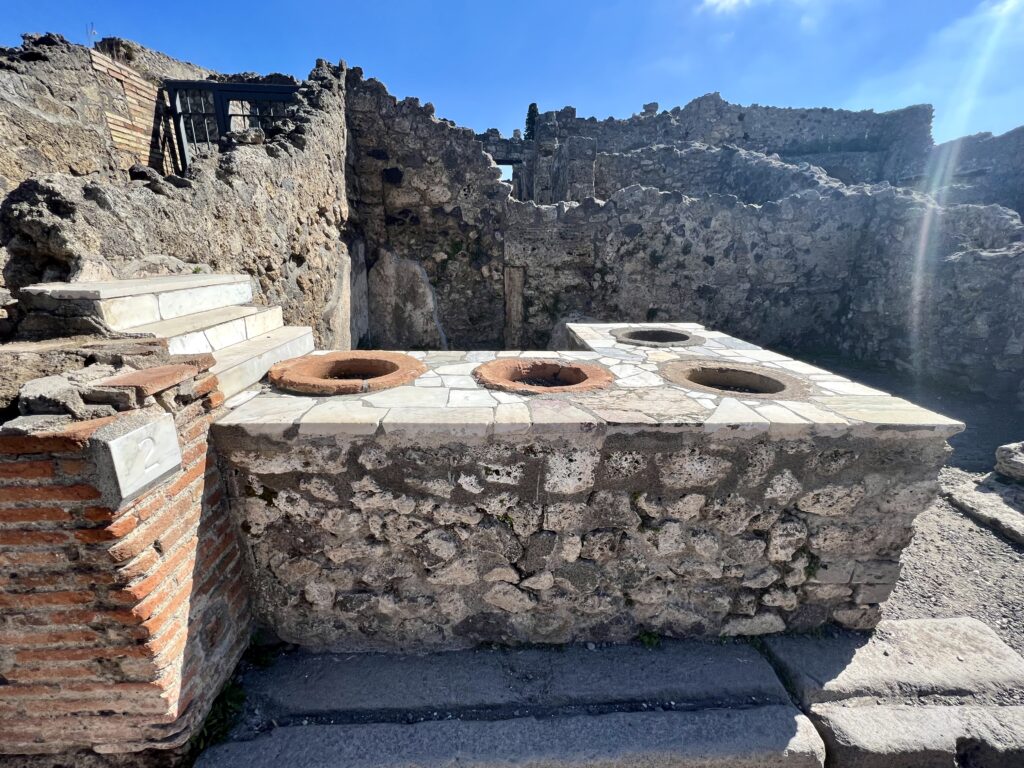
9. Fast Food Stands
Pompeii had over 80 fast food kiosks. The remains show that takeaway culture was an essential aspect of Roman life.
The fast food stands known as thermopolia . The y were popular places for the ancient Romans to grab a quick meal or snack.
A thermopolium consisted of a counter with openings (called dolia )where containers or jars filled with food and beverages were displayed. The food offerings typically included items like stewed meats, marinated fish, cheese, and vegetables.
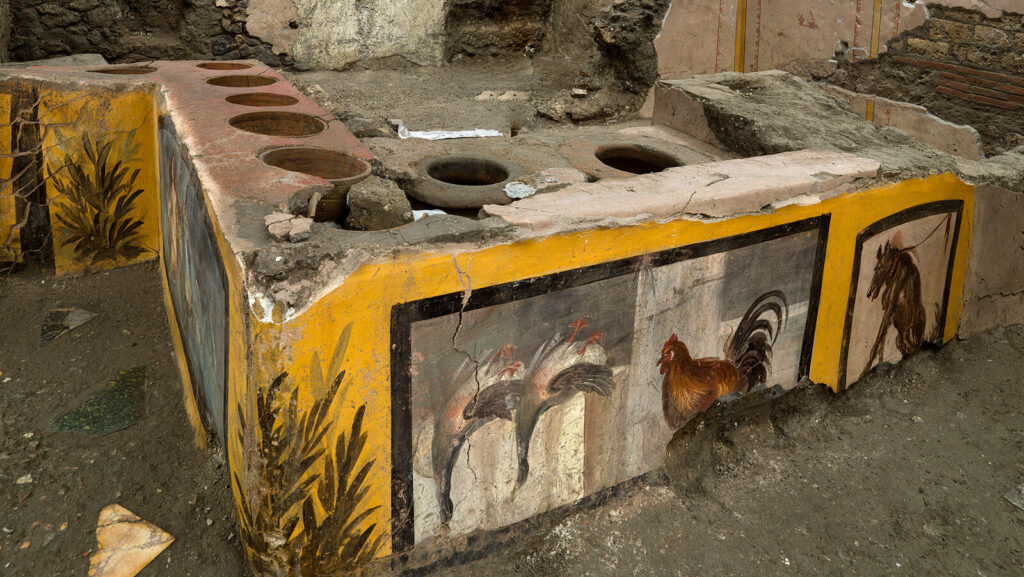
The food in the thermopolia was usually prepared in advance and kept warm in pots or pans placed in hot water or on hot coals. Customers could enjoy their meals standing at the counter or take them away in clay or ceramic containers.
In 2019, a richly decorated thermopolium was discovered in Region 5. It opened to the public in August 2021.
The thermopoli um had a multi-sided counter. The counter was covered with fresco decorations, including a dog on a leash, geese, and an undersea nymph riding a horse.
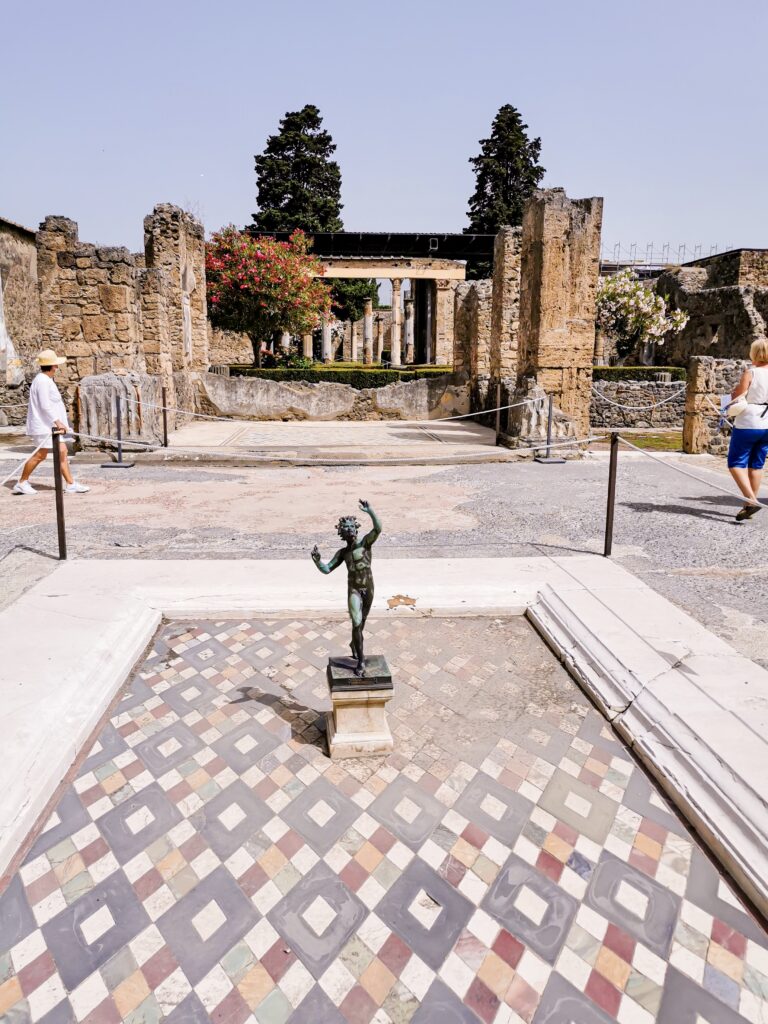
10. House of the Faun
You won’t find any frescos in the House of the Faun, but you should still make a quick visit for its architectural grandeur. It was the largest and sophisticated domus in Pompeii. It took up an entire city block.
It has two inner courtyards, rather than the usual single one. There were also four dining rooms, or triclinia , one for each season.
The House of the Faun is most famous for the huge cache of ancient tessare mosaics found there, which are now in the Archaeological Museum.
Indeed, it was home to the most impressive mosaic from Ancient Rome — the Alexander Mosaic , from the 2nd century B.C. The mosaic depicts a battle between the armies of Alexander the Great and King Darius of Persia.
The original mosaic, which is currently being restored, is in the Naples National Archaeological Museum. But there has been an exact reproduction onsite since 2005.
11. House of Menander
The House of Menander is one of the most famous and well-preserved residences in Pompeii. It’s right in the center, so you can’t miss it.
The house is named after a Greek dramatist whose portrait was discovered within its walls. This grand house was owned by a wealthy and aristocratic Pompeiian family.
The large house has intricate frescoes, colorful mosaics, and exquisite architectural details. Its layout consists of multiple rooms, including a central atrium, a peristyle garden, dining areas, and living quarters.
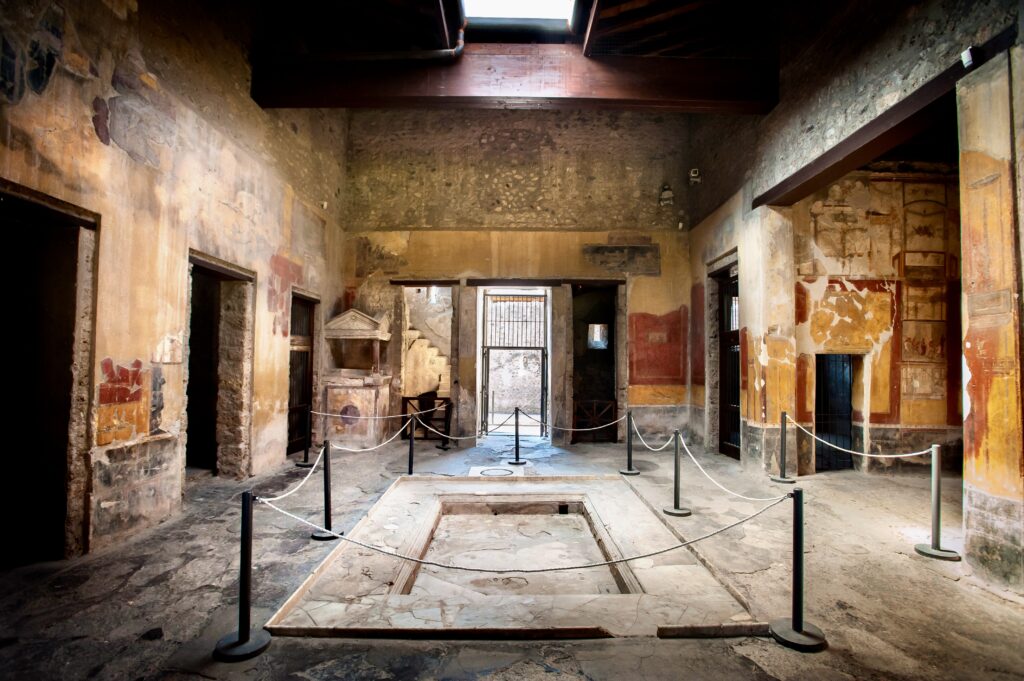
This house is where you’ll find some of the best in situ frescos in Pompeii.
They depict mythological scenes, landscapes, and intricate architectural elements, showcasing the artistic mastery of the time. One mosaic depicts grotesque pygmies on the Nile, which was inspired by the Roman conquest of Egypt in 30 B.C.
One of the highlights of the house is the large triclinium, or dining room, where elaborate banquets and social gatherings would have taken place.
The atrium features a beautiful impluvium , a sunken pool that collected rainwater. It’s home to scenes from the Iliad and the Odyssey .
In an underground corridor of the building, archaeologists discovered a 118 silver set that is now in the Archaeological Museum.
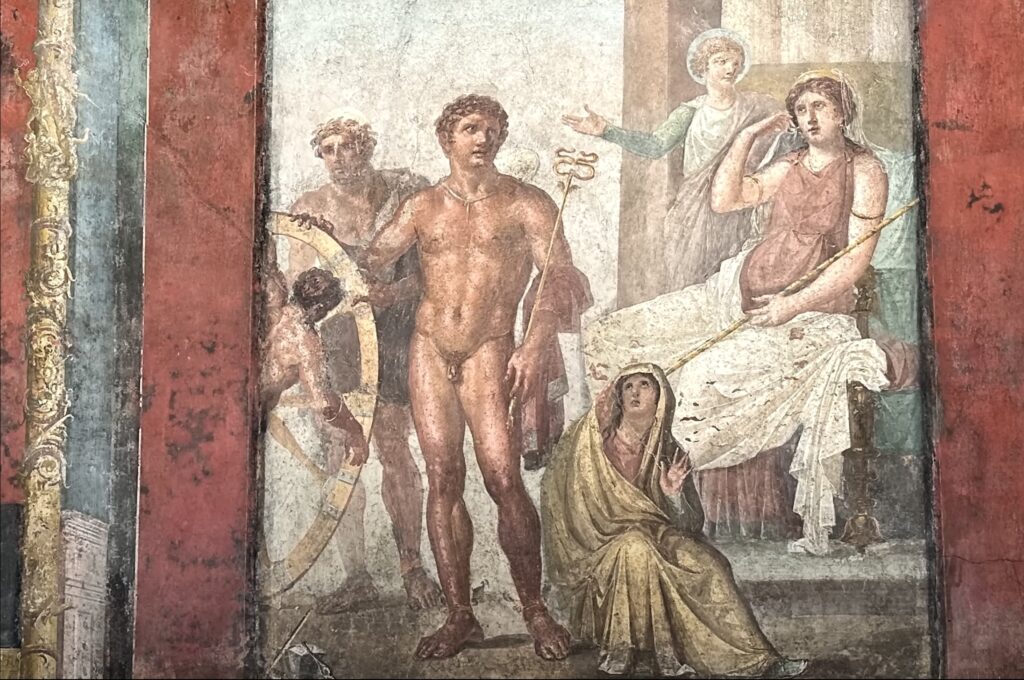
12. House of the Vettii
The House of the Vettii just reopened to the public in January 2023 after 2 decades of restorations. I’m so glad that I could see it!!
The house was renowned in ancient times for its mythological frescos and statuary. It was owned by two brothers, who were former slaves, from the Vettii family. They hit the jackpot in the wine trade and spent lavishly on their home.
At over 11,000 square feet, it was one of the largest houses in Pompeii. Right now the restored frescos are still in situ .
When you walk in through a red reception hall, you are immediately greeted by a fresco of the minor god Priapus. He’s weighing his mammoth member on a scale against a bag of gold.
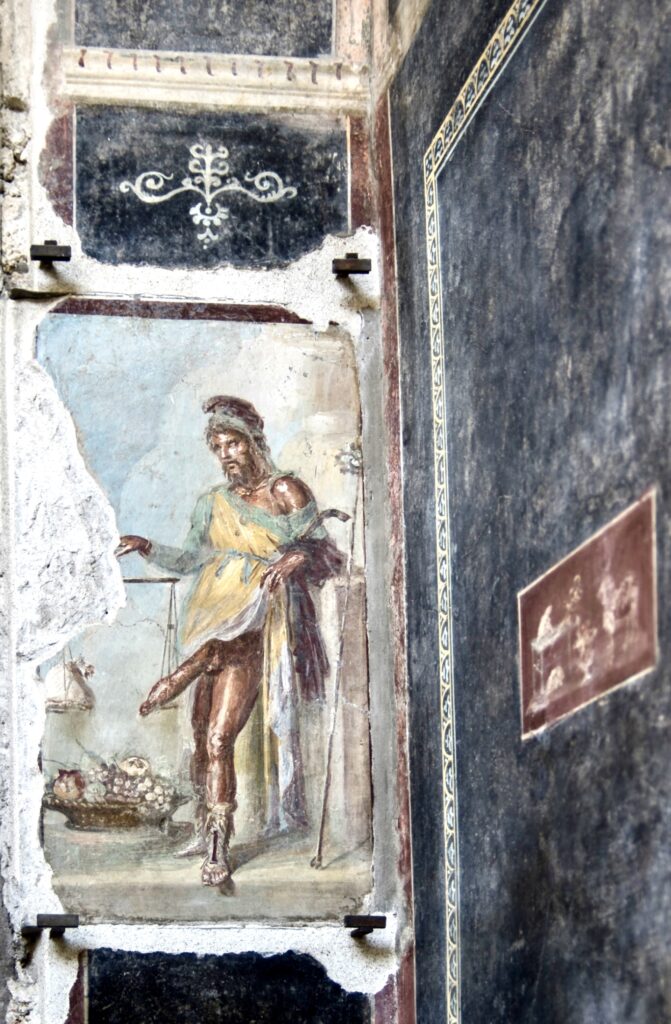
It’s an image you likely won’t forget. Yet, phalluses were ubiquitous in Roman life. They represented wealth and fertility and also warded off the evil eye.
The main dining room has the best preserved frescos, with images of Jupiter. There’s a remarkable frieze of tiny cupids wrapping around the room. They are depicted performing everyday tasks of daily life at the time.
In another small dining area with yellow frescos, you’ll see a fresco of a baby Hercules strangling some snakes. In the outdoor peristyle is a marble statue of Priapus (also enormous).
13. House of the Mysteries
From the House of the Vettii, you can make your way to the Villa of the Mysteries. It’s outside the city walls in the suburbs of Pompeii.
The house dates from 100 B.C. But its current layout is from 70 B.C. when it changed ownership.
The domus is an astounding place. The dining room boasts one of the best preserved pictorial cycles from antiquity. They are partly lit by natural light through two windows.
The large scale frescos are thought to depict a young girl, possibly a bride, being initiated into the mysteries of the secret Dionysian cult. Since the cult was a secret religion, the practices were mysterious and hence gave the house its name.
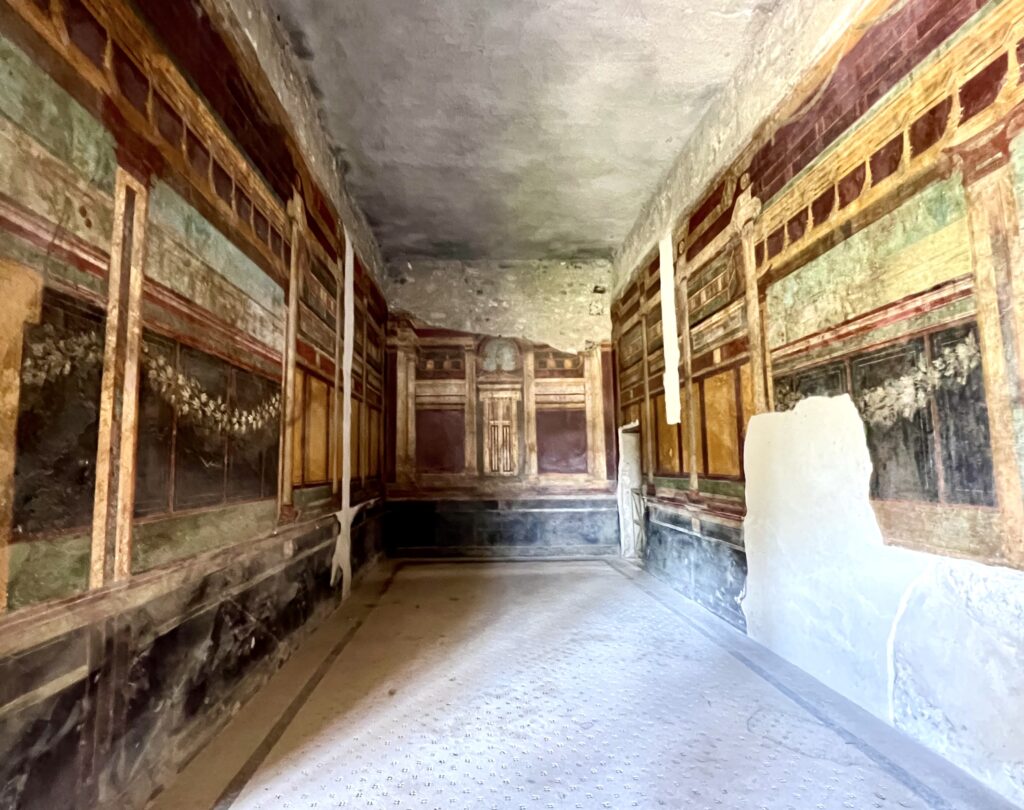
The scenes unfold across along three walls in a large room known as the Initiation Chamber.
The frescos are filled with symbolic and allegorical imagery. Dionysus (who looks tipsy) and his followers are depicted in vivid colors, dynamic poses, and ecstatic revelry. There are beautiful reds, greens, purples, and blues.
The exact meaning of the fresco is still disputed among scholars. Some think they are mere decoration or a more personal narrative depiction of the girl. Or perhaps just deal with the more general theme of female initiation.
There are also other rooms with second style Pompeiian wall paintings, which contain architectural decorations. All the frescos were restored between 2013-15 in an almost $1 million renovation and they are very vibrant.
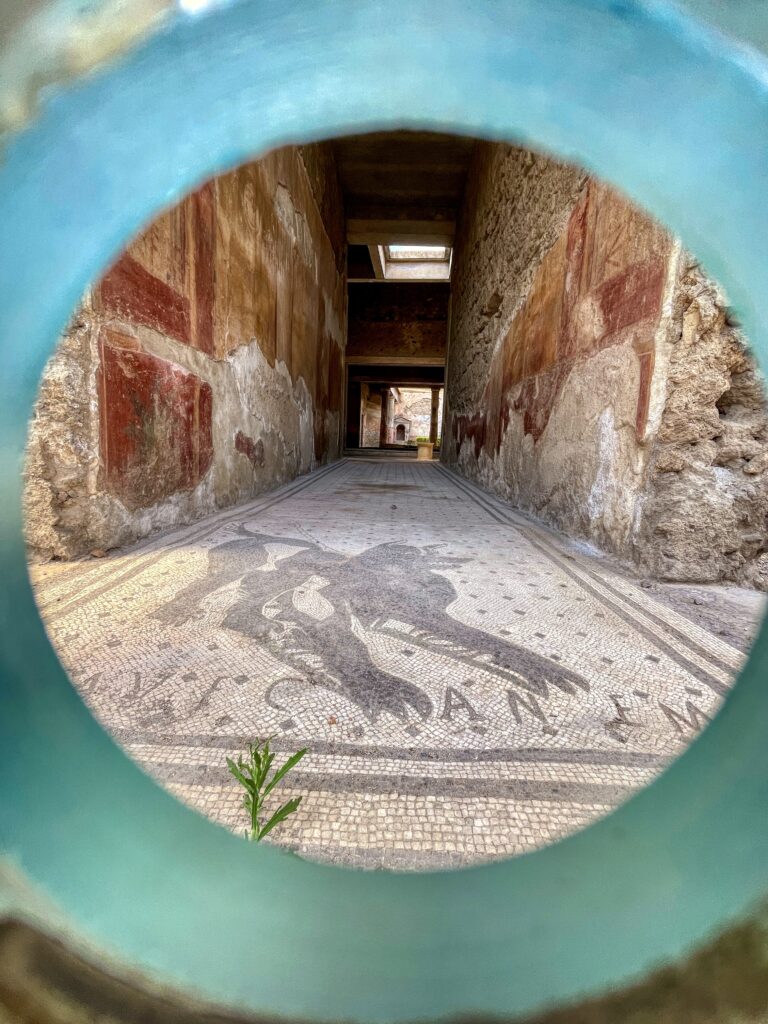
14. House of the Tragic Poet
The House of the Tragic Poet is is a centrally located house just opposite the Forum Baths and is worth a quick peak (if it’s open). It’s smaller than the other grand houses in Pompeii, so you can see how the middle class lived.
Its name comes from a famous mosaic depicting a poet and his troupe rehearsing a play. You can see that mosaic is in the Naples Archaeological Museum.
The atrium of the house was once decorated with six large frescos illustrating scenes from the Iliad .
Today, the domus is famous for its mosaic at the entrance, which is still in situ . It’s a floor mosaic of a fierce chained dog. It comes with a warning Cave Canem , beware of the dog.
15. House of Venus In The Shell
The House of Venus in a Shell is a well-known house in Pompeii named after a fresco found onsite. The house is notable for its exquisite frescoes, intricate mosaics, and architectural elements that depict scenes related to the goddess Venus.
The most famous decorative element is the large fresco of Venus rising from a shell, which is located in the peristyle area. This iconic depiction of Venus, known as the Birth of Venus, is a beautiful example of ancient Roman art.
The house also includes other frescoes portraying mythological and everyday scenes, as well as well-preserved architectural features such as columns, courtyards, and garden spaces.
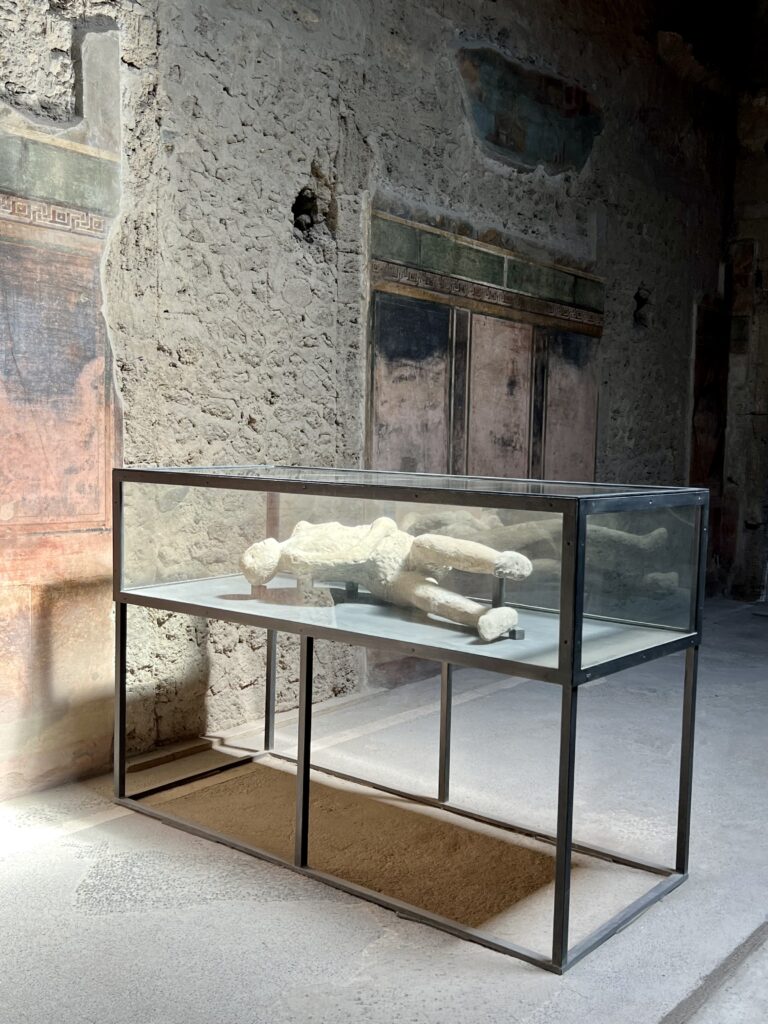
16. Preserved Plaster Casts
Scattered throughout Pompeii’s sites, you will see plaster casts. They are a poignant reminder of the human tragedy that unfolded in Pompeii.
The casts are the city’s residents, who were horrifically frozen in time by the volcanic ash. The casts were made by pouring plaster into the voids left behind by the decomposed bodies that were buried under layers of ash and pumice.
The process created molds to preserve their forms. They capture the final moments and final expressions of the victims.
You can find quite a few casts in the Stabian Baths, the macellum, and the granary of the forum. There are also many on display in the Garden of the Fugitives in the northeastern corner of Pompeii. You may need a map to find it.
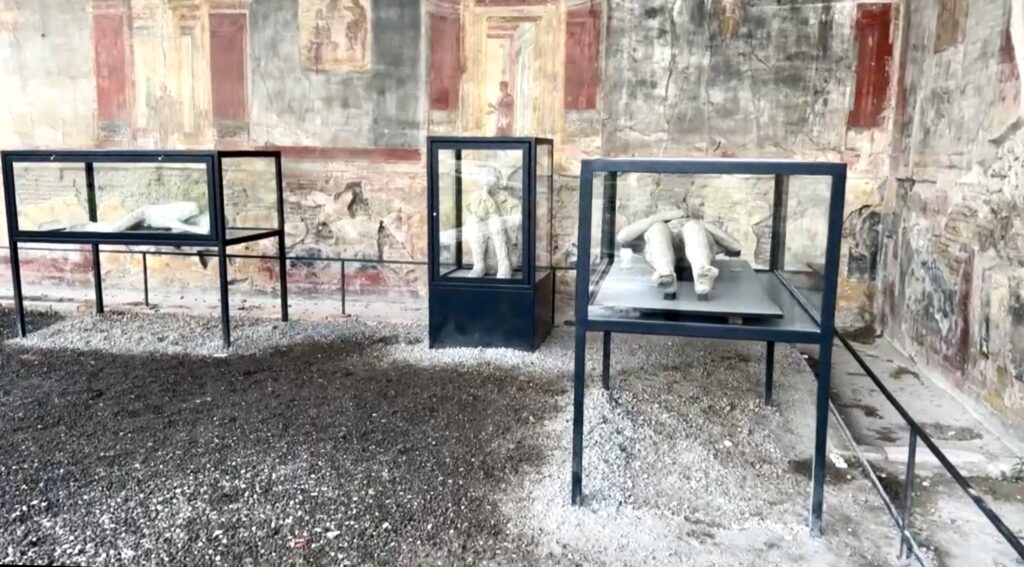
17. Regio V, Leda and the Swan
In 2018, a racy fresco was discovered during excavations at Pompeii’s Regio V area. Though tiny, it’s a very unique fresco. You can see it from the street.
It depicts the mythological event when Leda is raped by Zeus in the guise of a swan. As a result of their union, Leda gives bath to Helen, the women who launched the Trojan War.
The fresco has some unique features. First, Leda is portrayed sitting instead of standing. Second, she stares out at the viewers, making them a voyeur in her rape.
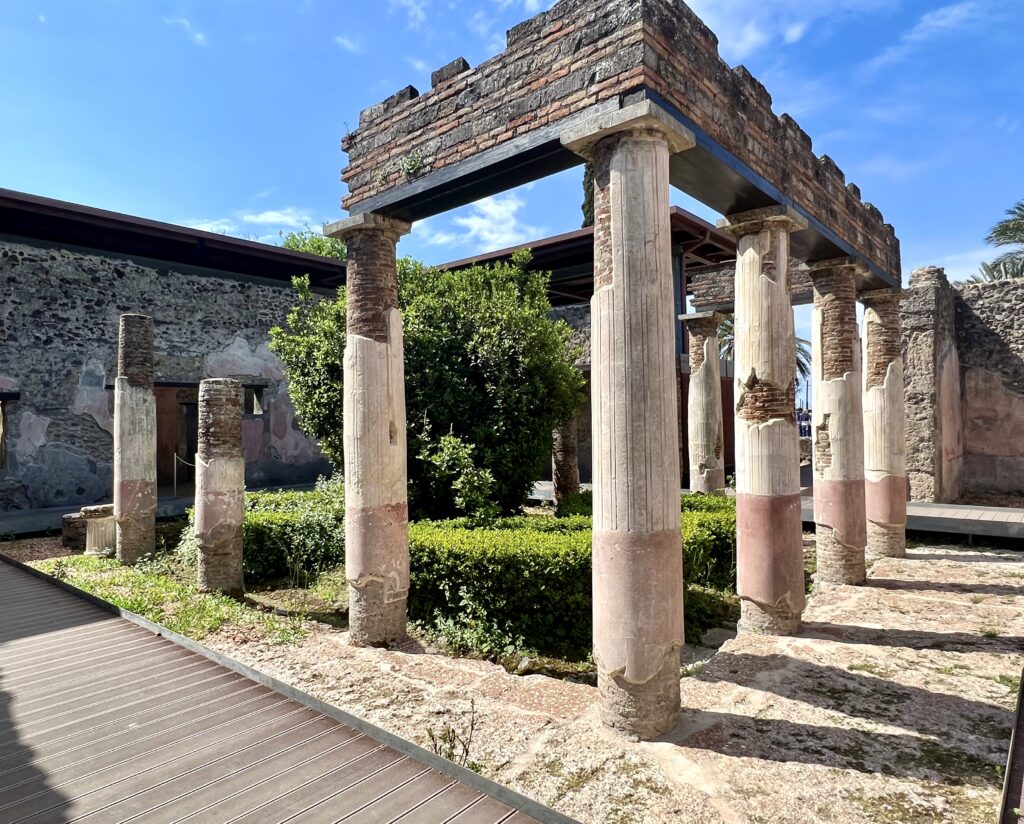
18. House of Diomedes
The House of Diomedes is located along the Via dei Sepolcri near the necropolis. It was built around 200 B.C. and belonged to various high ranking families.
The villa derives its name from graffiti mentioning Diomedes found on one of its walls. Diomedes was a wealthy citizen and, possibly, a notorious figure of criminal repute.
The house was one of the first things to be excavated in Pompeii. So, it attracted a large following of men on their grand tours of Europe in the 19th century.
The house consists of rooms arranged around a 14 column central atrium. Like many villas, it had an impluvium to collect rainwater.
18 women met their death inside the house, as they tried to flee from the eruption of Vesuvius. Their remains were discovered during excavations.
After restorations during the Great Pompeii Project, the domus opened to the public in September 2022.
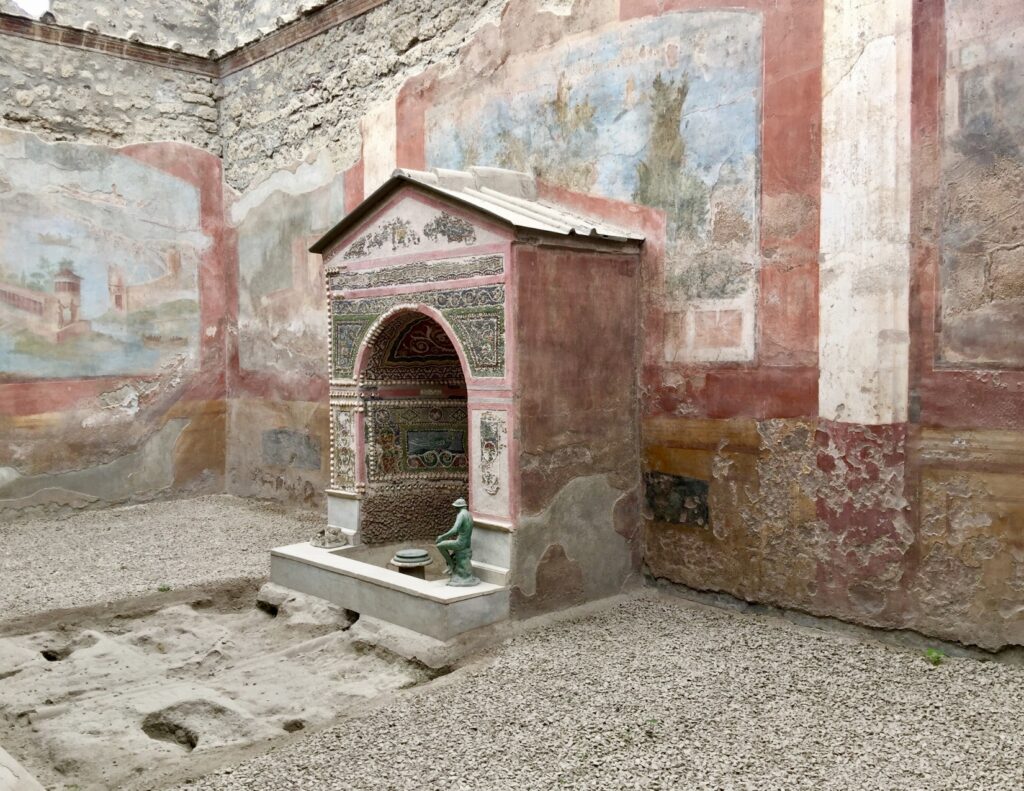
19. House of the Small Fountain
This is a small house that’s also worth a glance. it’s a middle class domus .
The house is know for the its beautiful mosaic fountain in the central courtyard or peristyle. The fountain is situated so that you can see it from the entrance.
The fountain has been restored. The side walls around it contain very faded frescos of landscapes and maritime buildings, which were probably in the 4th Pompeiian style.
The fountain has a miniature arch and triangular roof. There are tiny bronze statuettes on both sides.
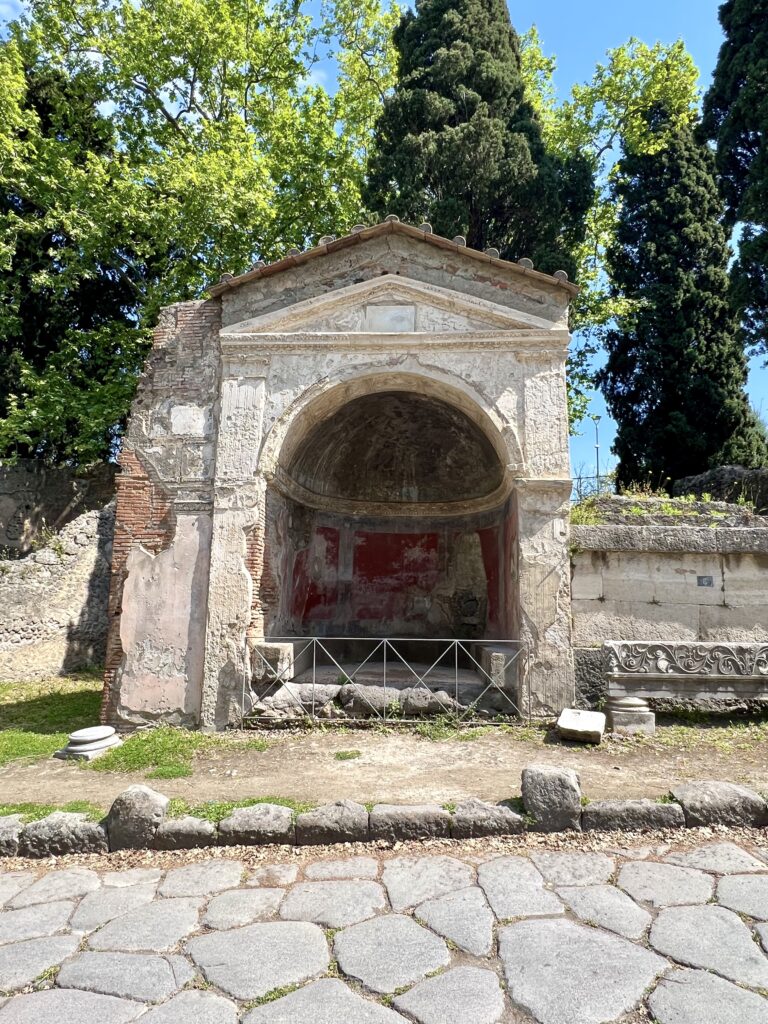
20. Necropolis
On your way to the Villa of Mysteries, you will pass down the tomb-lined Via dei Sepolcri known as the Street of Tombs. It’s an ancient burial ground located just outside the city limits, along the road that leads to Herculaneum.
This is where many citizens of Pompeii were buried. There are large range of burial tombs. Some are simple structures.
Other are ornate mausoleums, with intricate reliefs. Inscriptions prove some clues about who might be buried there.
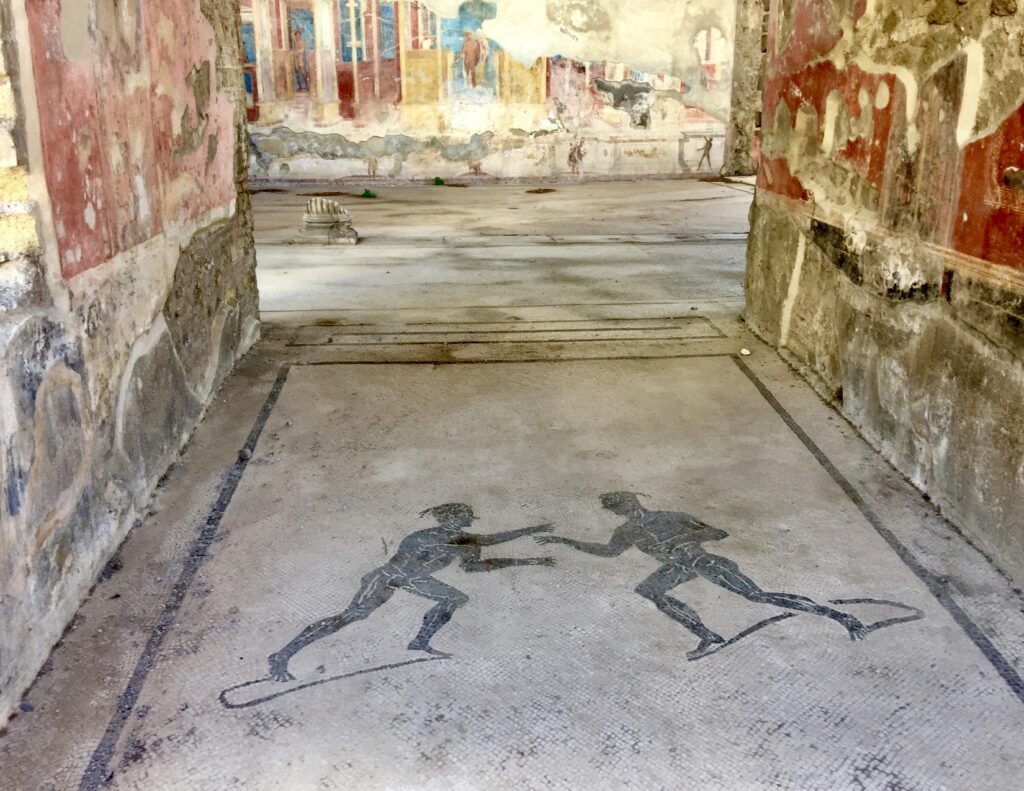
Practical Guide & Tips For Visiting Pompeii
Now, let’s get down to the nitty gritty. No guide to Pompeii would be complete without some must know tips for visiting this wondrous site. And I have quite a few for you.
1. How To Get To Pompeii
You can access Pompeii from Rome, Naples, or the Amalfi Coast. There are various ways to get to Pompeii, and I describe them below.
But a car gives you the most flexibility. You can leave whenever you want and are done exploring.
The easiest way to get from Rome to Naples is by train. You can catch a high speed train from Rome’s Termini or Tibertina train stations to Naples. This will take about one to 1.5 hours.
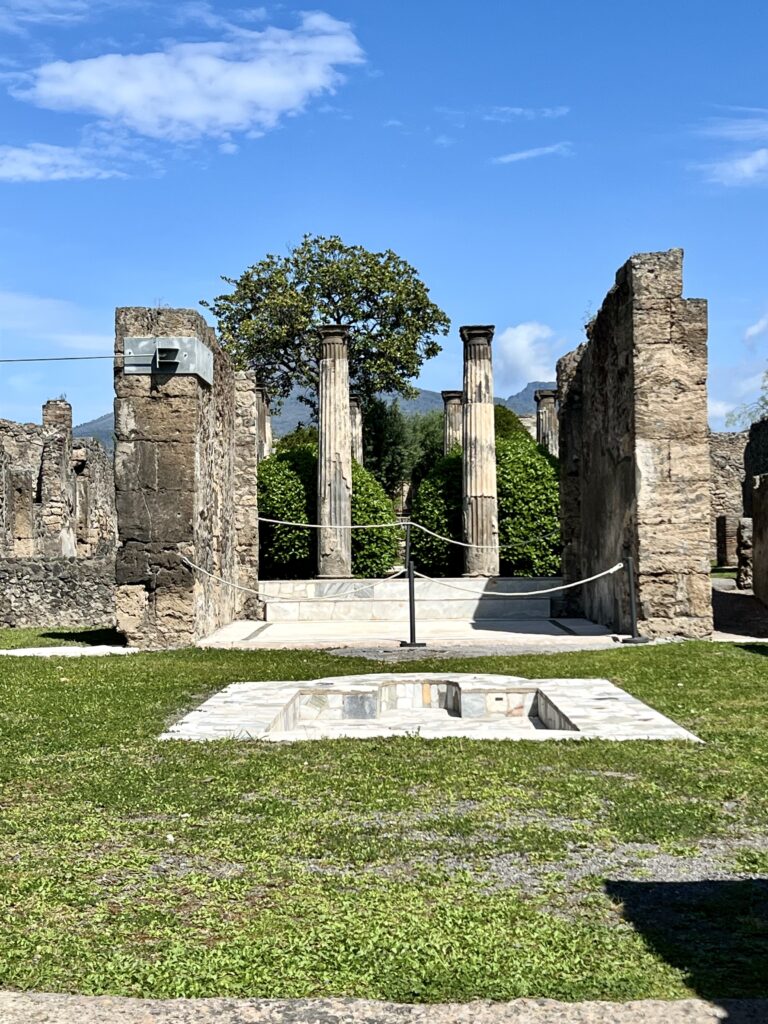
In Naples, you must transfer to a regional train in Naples’ Station Porta Nolana-Circumvesuviano and disembark at Pompeii’s Scavi-Villa dei Misteri.
The train will take about 30 minutes. The Pompeii train station is right next to the Porta Marina entrance to the archaeological site.
You can also take the bus (2-3 hours) or drive from Rome to Pompeii. Depending on traffic, driving will take about 2.5 hours. It’s 150 miles between the cities.
In addition, beginning on July 16, 2023, there will be a direct train service from Rome to Pompeii every third Sunday of the month. Passengers can watch a video about Pompeii and purchase tickets onboard.
And you can always book a guided day tour from Rome to Pompeii . This 13 hour guided tour gives you an overview of both Naples and Pompeii.
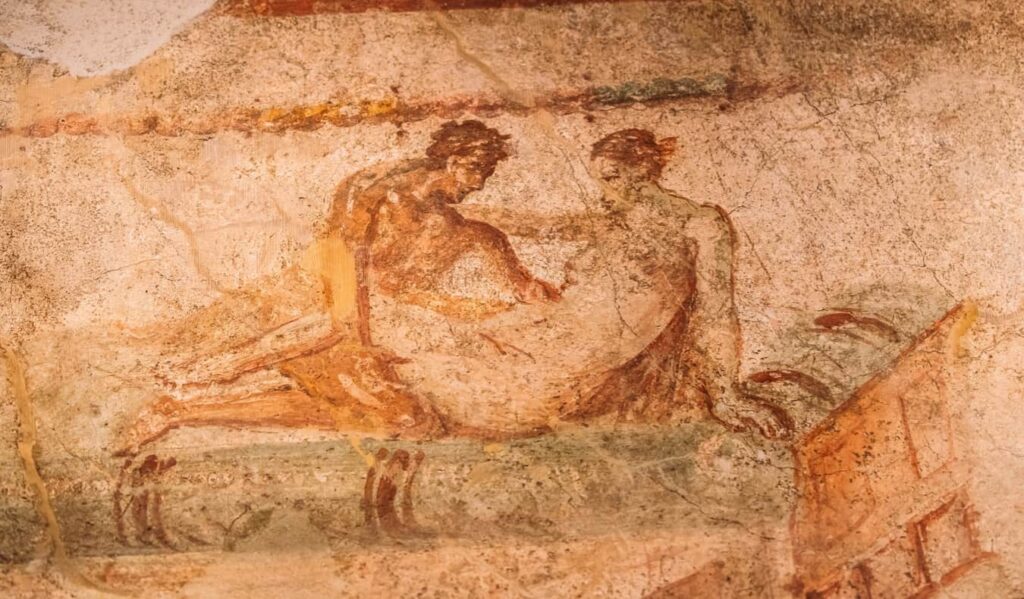
From Naples:
If you want to go by train fro Naples to Pompeii, it’s just 30 minutes. You take the Circumvesuviana train train from Napoli Centrale or from the Napoli Porta Nolana station.
You can also drive there in 30 minutes. There are parking lots near the archaeological site. But they can fill up fast in high season.
You can also book a private transfer from Naples , which is what I did and met my guide there. If you choose this option, you can have your driver drop you at the main entrance and pick you up near the Villa of Mysteries at a designated time.
Alternatively, from Naples, you can book a:
- guided full day tour that includes Pompeii and Vesuvius
- guided tour of Pompeii and the Amalfi Coast
- guided tour tour of Pompeii and Herculaneum with an archaeologist
From the Amalfi Coast:
If you want to visit Pompeii from the Amalfi Coast, you can catch a train from Sorrento. Or you can book a guided tour from Sorrento . You can also book a guided tour from Positano or one from Salerno .
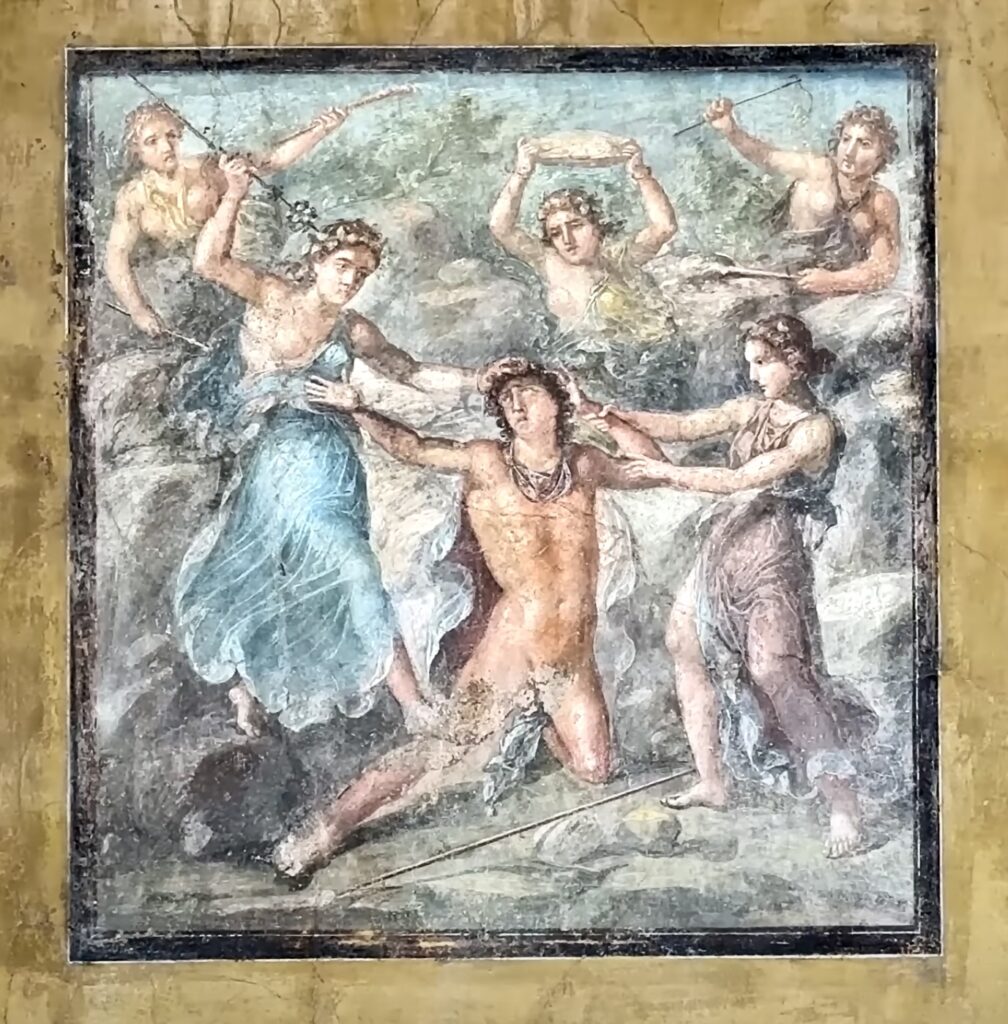
To avoid waiting in line, you should book a skip the line ticket on Get Your Guide or a fast track ticket on Viator in advance.
Like other museums in Italy, Pompeii is free to visit on the first Sunday of the month. But you should expect heavy crowds.
3. Entrances
There are two primary entrances to the archaeological site. The first entrance is Porta Marina, located in the southwest, with the adjacent Piazza Esedra.
This entrance serves as the main gateway and offers convenient access to the major attractions within Pompeii. It’s also where you can obtain an audioguide.
Due to its proximity to the main points of interest, Porta Marina tends to be busier, especially during peak periods. Therefore, it’s advisable to anticipate potentially long queues for ticket purchases.
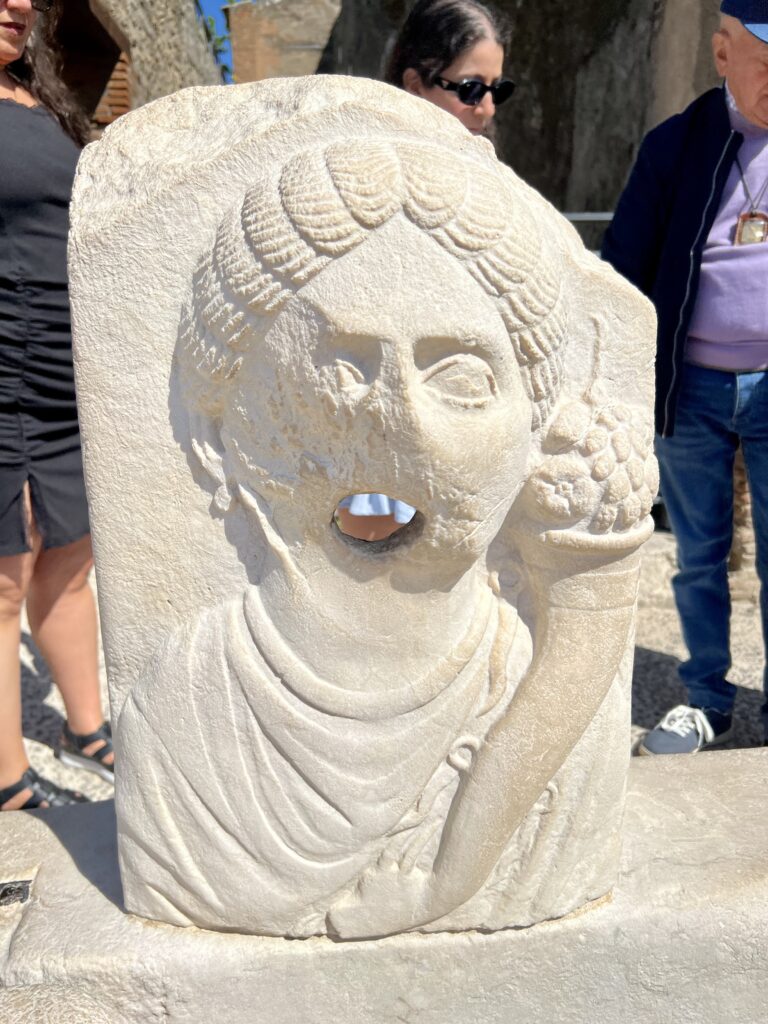
Alternatively, the second entrance is Piazza Anfiteatro, situated in the southeast of Pompeii.
While less crowded compared to Porta Marina, it still provides access to significant areas of the site, including the amphitheater. This entrance may be a suitable option for those seeking a quieter and more relaxed visit.
4. Opening Hours
From April 1 to October 31, Pompeii is open from 9:00 am to 7:00 pm. The last entry is at 5:30 pm. From November 1 to March 31, the site is open from 9:00 am to 5:00 pm with the last entry at 3:30 pm.
Be aware that, even though sites may be listed as open on the website, they may be closed when you visit. Or, they not be open for the entire time the archaeological site is open.
Things seem to close on whim sometimes. You will not necessarily know when and if restoration is being done.
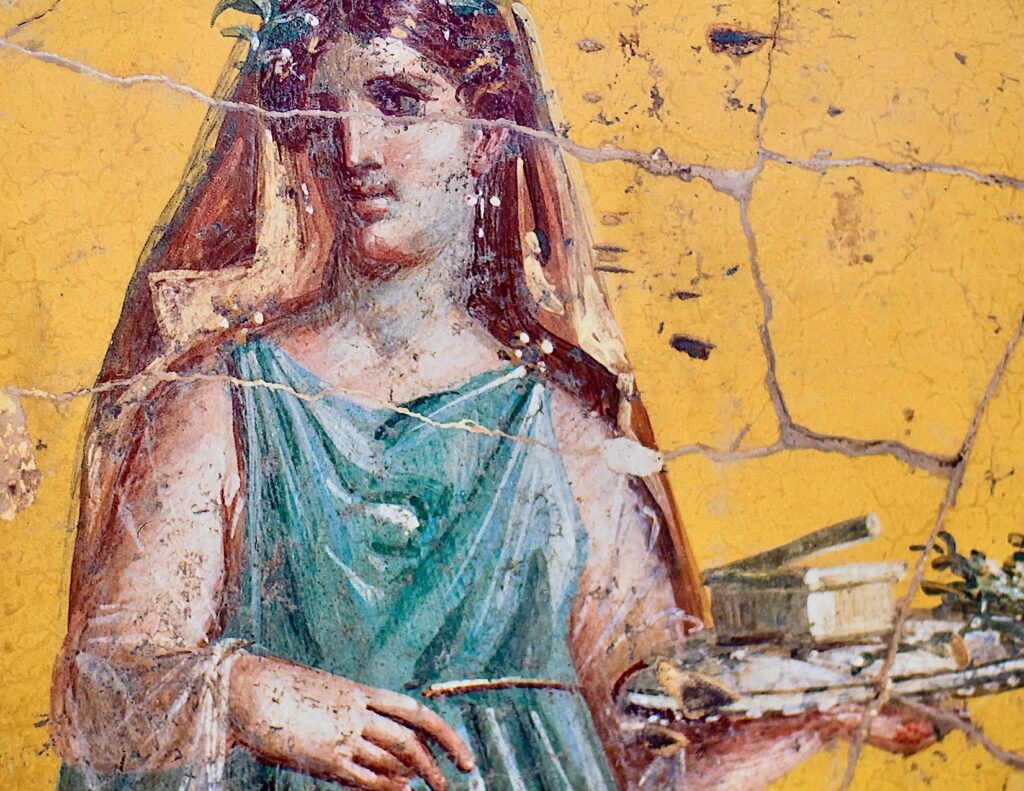
5. When Is The Best Time To Visit Pompeii?
Not on a weekend! Try to visit on a weekday or during the off season to avoid crowds at Pompeii
I also don’t think it’s best to arrive when Pompeii first opens. There will already be people waiting.
It’s better to visit in the mid afternoon during high season. By that time, some of the cruise ship visitors will have departed and the site will be quieter and less crowded.
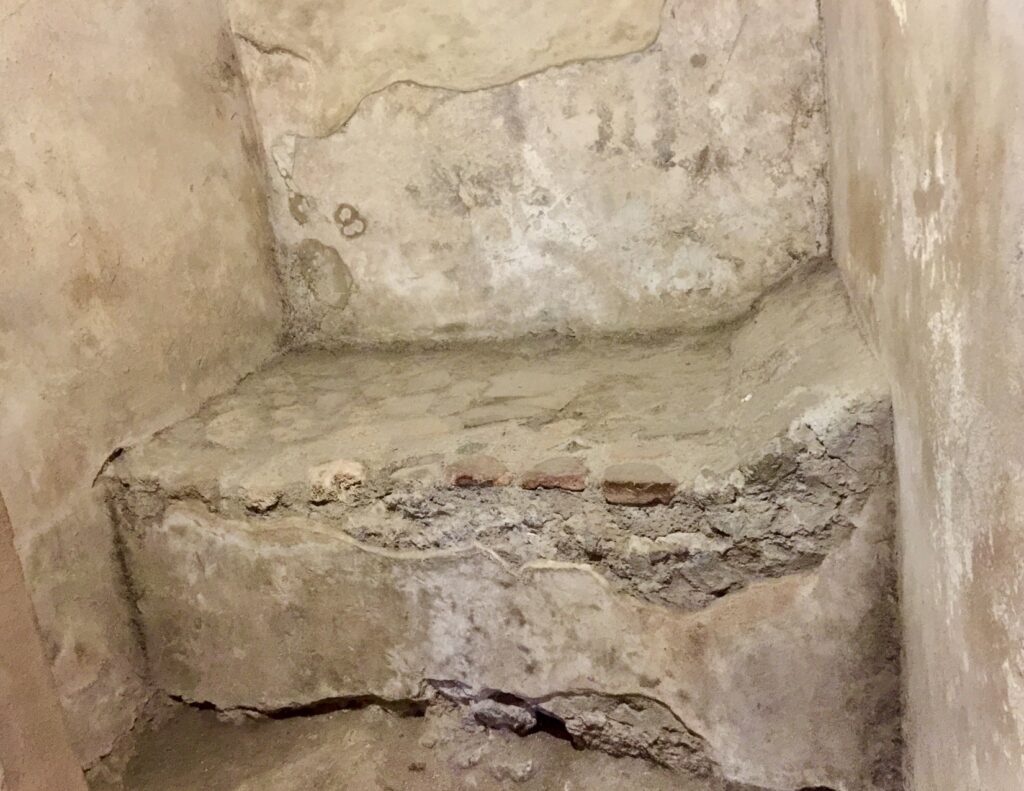
6. How Much Time Do You Need For Pompeii?
This depends on how much you like ancient history. But you could easily spend all day at the archaeological site.
Pompeii is a city after all. It sprawls out over a large area. For example, it takes a full half hour to walk from the amphitheater to the outlying Villa of Mysteries.
Most visitors only see the main attractions in the center on a quick tour. Try to concentrate on the main sites and don’t get bogged down on all the side streets.
While 2 hours may be all the time you have, I think Pompeii is better savored with a longer visit of 4-6 hours.
If you are already familiar with Roman theaters and forums from visiting other sites, I would instead focus on Pompeii’s star villas — the House of Menander, the House of the Vettii, and the House of the Mysteries.
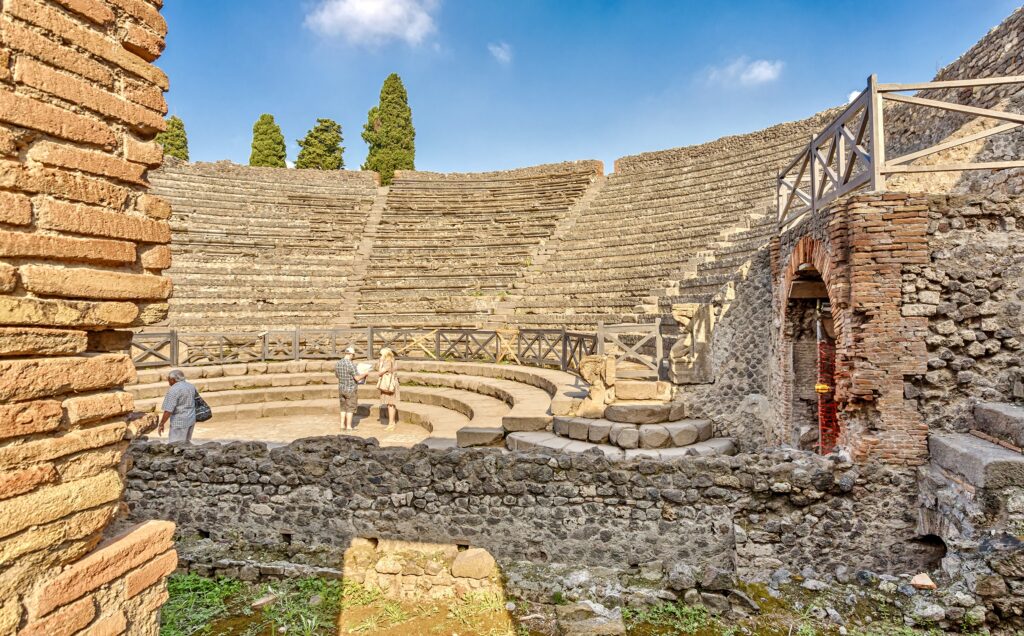
7. Proposed Pompeii Itinerary
If you are feeling ambitious and want to see as many sites as possible, here is an example of how you can proceed. Enter at the Marina Gate and turn right. Then, see these sites in the following order:
- Large Theater
- Small Theater
- House of Menander
- Amphitheater
- Walk down Via dell’Abbondanza
- Stabian Baths
- Forum of Pompeii
- Temple of Apollo
- Forum Baths
- House of the Tragic Poet
- House of the Faun
- House of the Vettii
- Villa of Diomedes
- Villa of the Mysteries
If you are shorter on time, you can eliminate the sites listed after the Forum Baths.
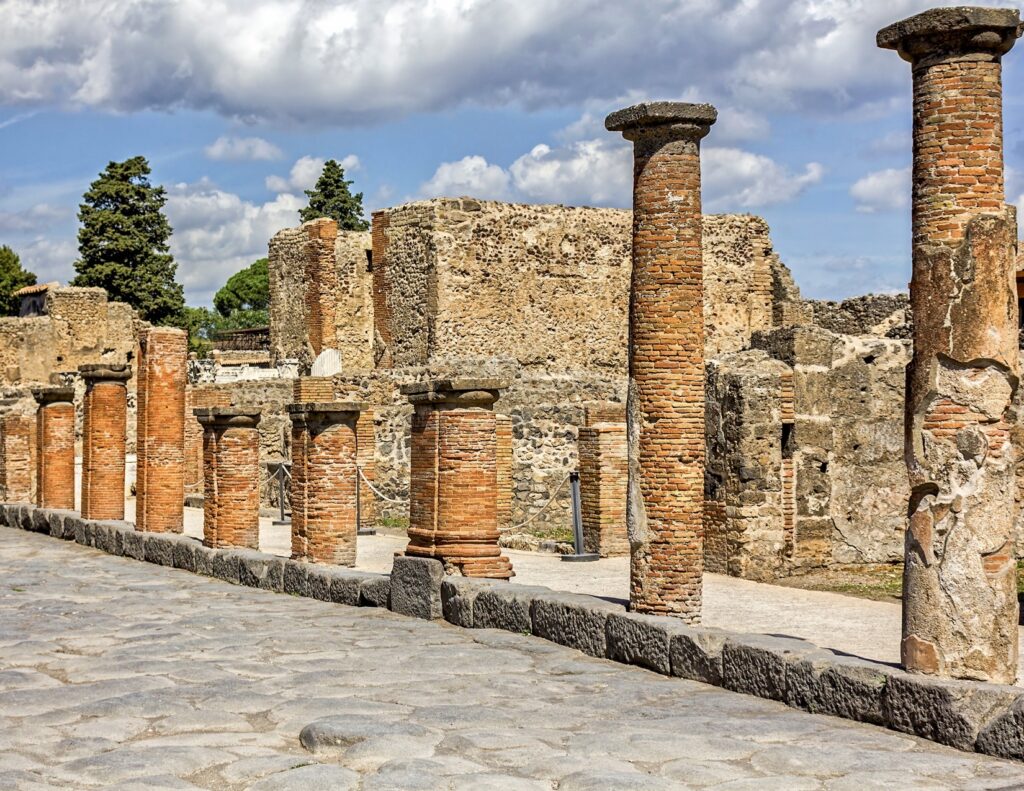
8. Pro Tips
To prepare for your visit to Pompeii, you may want to read the online booklet about the excavations. They’re divided by region. This will help you determine what to see.
On a practical note, Pompeii can be very hot. Be prepared with sunscreen and water bottles.
You should also wear comfy walking shores. You’ll be walling on uneven cobbled pavement the entire visit.
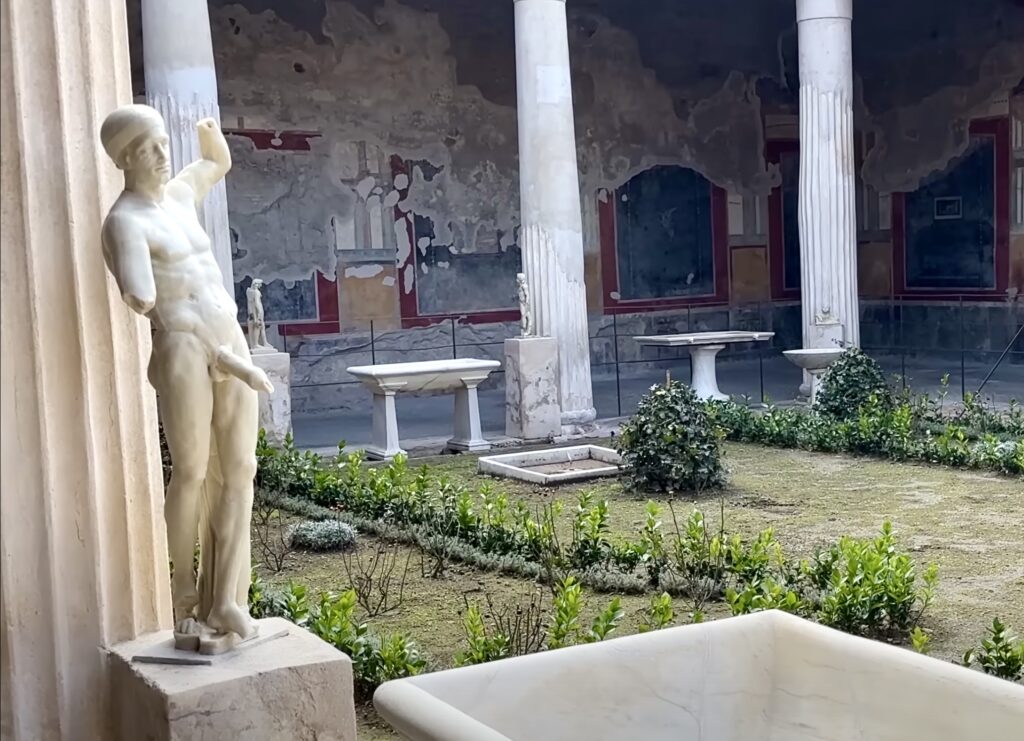
9. Where To Stay Near Pompeii
I can’t say that the town of Pompeii has much to recommend itself. Still, if you want to really take maximum advantage of seeing the ancient ruins, you may want to overnight in Pompeii.
I would check out the 4 star hotels in the area — Hotel Forum , Hotel Bosco De’ Medici , and Hotel del Sole .
If you are traveling from Naples, there are plenty of great places to stay. I can personally recommend the Eurostars Hotel Excelsior (5 star in Chiaia) and The Britannique Naples (Hilton Curio in Chiaia). Both hotels are in an upscale neighborhood with seaside views and near the metro.
You may also want to stay in Sorrento to access Pompeii. I stayed on the edge of town at the lovely Grand Hotel Cocumella .
You can also check out the Grand Hotel Excelsior Vittoria and the Palazzo Marziale . They are luxury hotels in lovely historic buildings.
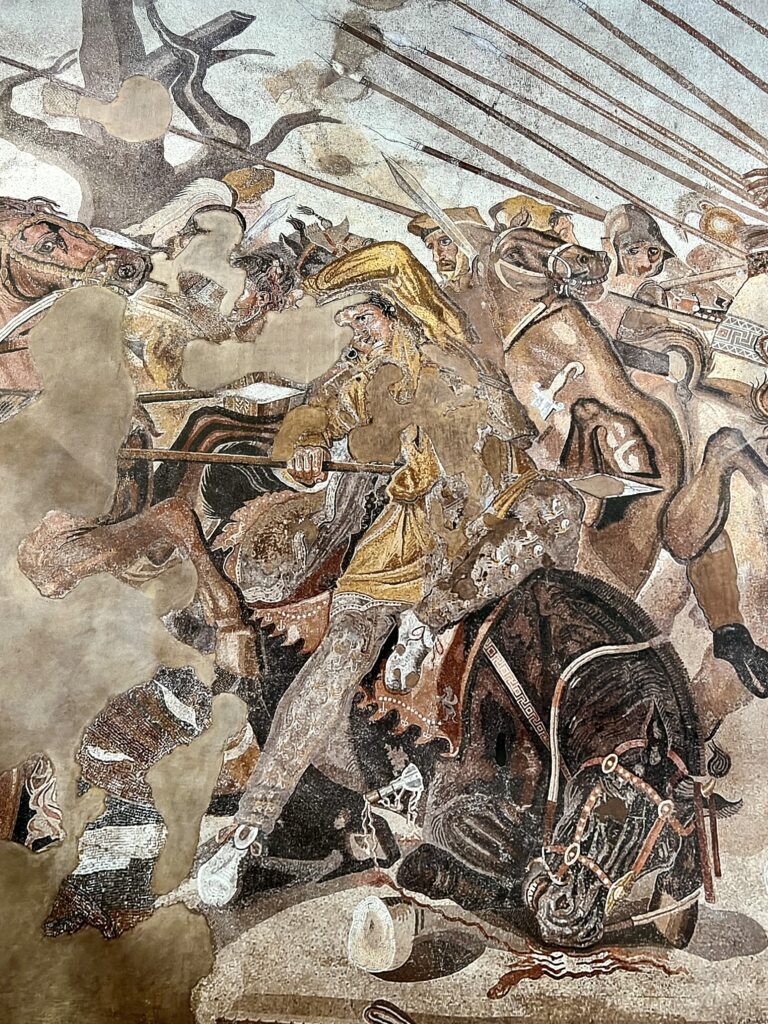
10. Naples National Archaeological Museum
As I mentioned, most of the actual treasures excavated from Pompeii are found in the Museo Archeologico Nazionale di Napoli .
This is a fantastic one-of-a-kind museum located in Naples’ centro storico . You’ll find a huge cache of frescos and mosaics from Pompeii, along with Roman statuary from the Farnese collection.
Ideally, you should visit the museum first before visiting the ruins of Pompeii. That way, you’ll have an idea of what the city once looked like in its glory days.
In high season (May to September), I advise booking a skip the line ticket for the museum. This is an extremely popular place. I took this private tour of the museum with an archaeologist and loved it.
I hope you’ve enjoyed my guide to visiting Pompeii. You may enjoy these other Italy travel guides and resources:
- 3 day itinerary for Rome
- 5 day itinerary for Rome
- 1 day itinerary for Vatican City
- 3 day itinerary for Florence
- 2 day itinerary for Venice
- 1 day itinerary for Milan
- 1 day itinerary for Siena
- One week in Umbria
- 10 days in Italy itinerary
- 10 day itinerary for Tuscany
- 12 ways to spend 1 week in Italy
- 2 weeks in Sicily itinerary
If you need a guide to Pompeii, pin it for later.
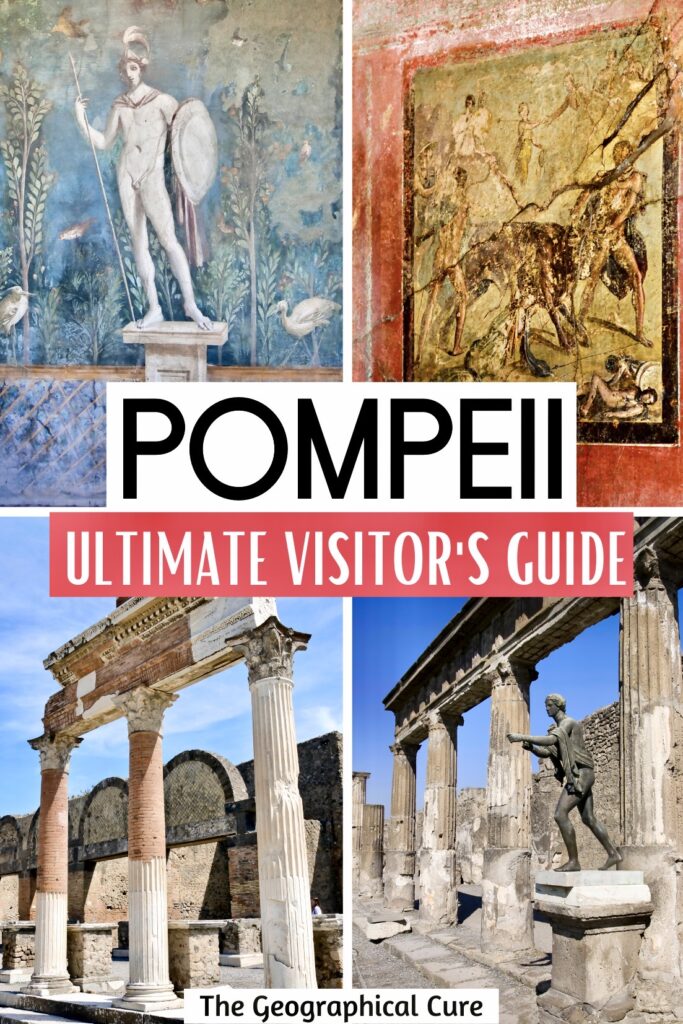
Leave a Comment Cancel reply
Save my name, email, and website in this browser for the next time I comment.
Last Updated on March 22, 2024 by Leslie Livingston

IMAGES
VIDEO